I was late to the LCR party. As I mentioned in my previous article, the gun’s radical looks were a turnoff to my conservative tastes, and I didn’t get excited about it until I started getting some trigger time on them. Then, the performance caught my immediate attention, and I realized I’d been missing out on a helluva gun.
The Ruger 9mm LCR
My initial brush with the LCR was with the flagship, .38 Special model, but when Ruger launched the 9mm version, my curiosity was piqued. When a trusted friend gave it a thumbs up, I became even more intrigued by the metric LCR. I wasn’t willing to buy one without shooting it first, however, so I delayed.
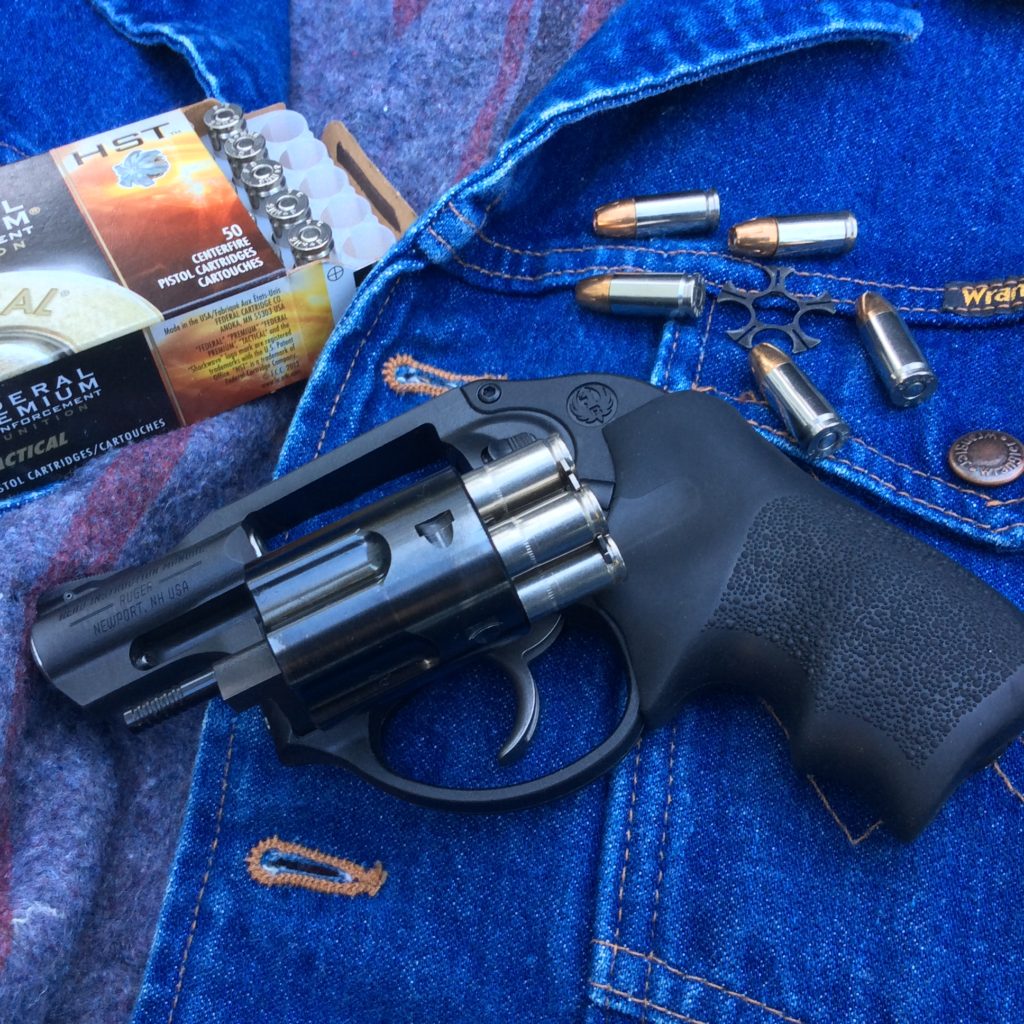
The opportunity to shoot the 9mm LCR finally came at SHOT Show Media Day a few years back, and I was smitten right away. I also shot the 9mm SP101 the following year, which I enjoyed very much, but my fancy for the LCR had grown strong by this point, and I knew I had to add the lightweight gun to my stable first.
A strange breed
It had taken me a while to get to this point, because the 9mm revolver, as a class, had always struck me as an odd duck.
The first one I recalled seeing was the Smith & Wesson Model 547, which was built in 1980 for the French police, but offered to the U.S. commercial market as well. The 547 incorporated a unique ejector system which made the gun work without the use of clips. The gun came in two flavors (a 4” square butt and a 3” round butt) and had all the right looks (blue steel and walnut—a classic recipe!), but I couldn’t figure out what it was good for. I understood the 9mm was popular in Europe and the French were probably sitting on a pile of it, but why would you chamber a revolver for an autopistol cartridge when the same gun could be chambered in a more efficient and powerful revolver cartridge, like the .357 Magnum? Why go through all the hassle?(1.)
The United States’ .45 ACP M1917 revolvers made sense to me as a wartime substitute because the M1911 was already the service standard, and we desperately needed more .45 ACP guns to fight the “War To End All Wars.” However, the French were trying to clean house and simplify things by going to a single revolver type, so ammunition compatibility wasn’t as important.(2.) I wrote the idea—and the interesting S&W 547–off as an oddity.
Later on, Ruger chambered some of their excellent “Six” revolvers for the 9mm (again, to pursue European contracts), but I dismissed them just as quickly. The Ruger guns were designed to work with clips, which actually made them more efficient to reload than the 547, but here at home—where .38 Special and .357 Magnum revolvers were still being carried as the standard police weapon—I didn’t see where they fit in.
In 1991, Smith & Wesson chambered their Centennial-style Model 940 in 9x19mm, and Ruger built some SP101s in the caliber around the same time, but neither of the guns lasted long in the catalog (the 940 was gone by 1998, and the Ruger a little before that, I think). The American market wanted their 9mms to feed from magazines, not clips, and demand was low. Interestingly, this generation of 9mm revolvers was the first to make me sit up and pay attention to the concept. I was finally catching on to the fact that the 9mm had better ballistic potential than the .38 Special, and the full moon clips now being offered could make unloading more positive, and reloading more speedy. Alas, the guns disappeared from the market before I got one, and I was left with a smoldering curiosity that would have to wait.
Another chance
So, when my new appreciation for the LCR intersected with the introduction of a 9mm version, I was a receptive audience. I didn’t have any experience with clip-fed revolvers (outside of a few cylinders through a 625 and a 610), and I was interested in exploring the combo.
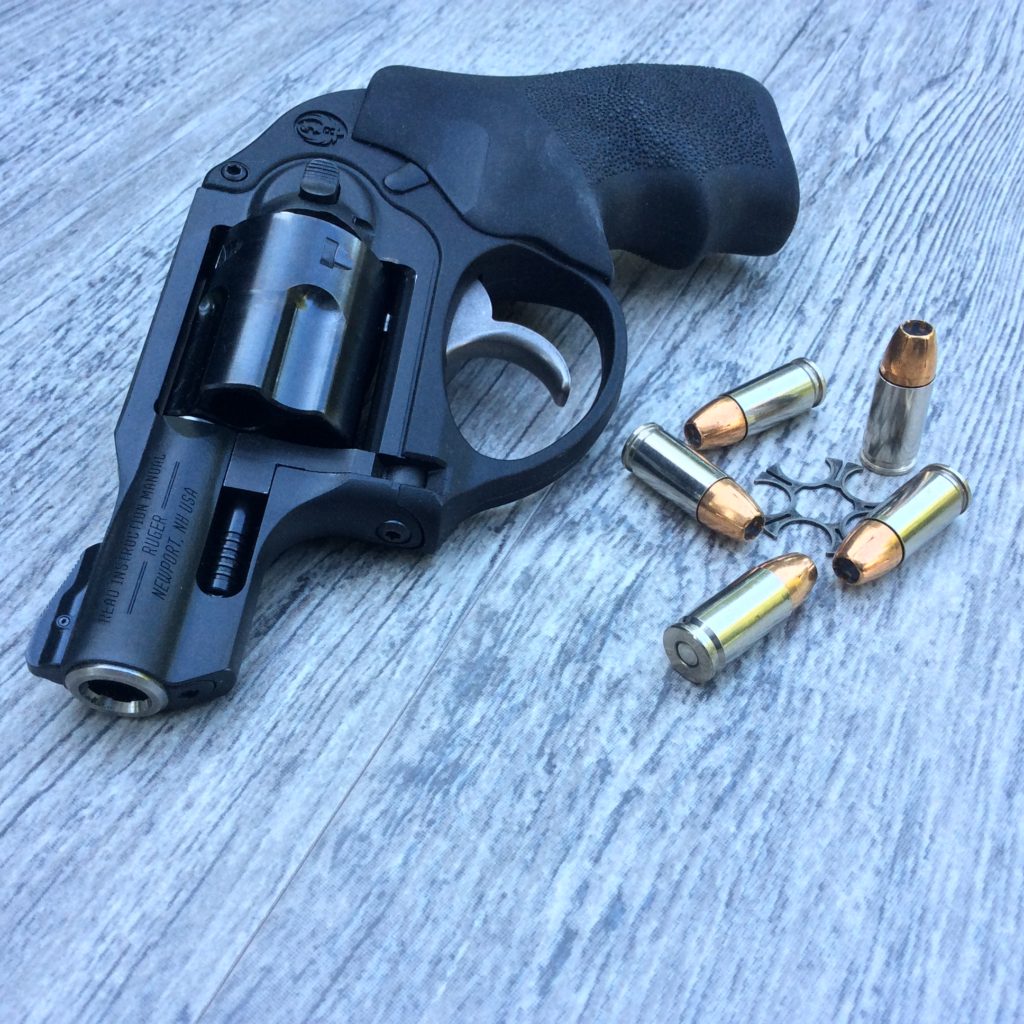
I was a little concerned about two things though. First, I’d read some reports that the 9mm’s recoil was more stout than the .38 Special +P in the J-Frame-sized guns, and I’d already decided that .38+P was my upper limit of controllability in a lightweight snub. Secondly, I’d read credible reports that the clip-fed revolvers suffered a greater number of reliability issues than guns chambered for revolver cartridges. Some of the reports complained of light primer strikes (due to variations in rim/groove tolerances and the “springiness” of the metal clips absorbing firing pin energy), and cylinder rotation interference from bent/damaged clips or bullet pull. I was interested to see if I would experience any of these things. The answer would tell me if the 9mm revolver could be relied upon as a defensive tool, or if it would just remain a novelty.
First shots
As mentioned, my first opportunity to shoot the 9mm LCR came at SHOT Show Media Day. The conditions at Media Day aren’t conducive to really getting to know a gun, but I did walk away from the experience with some important tidbits.
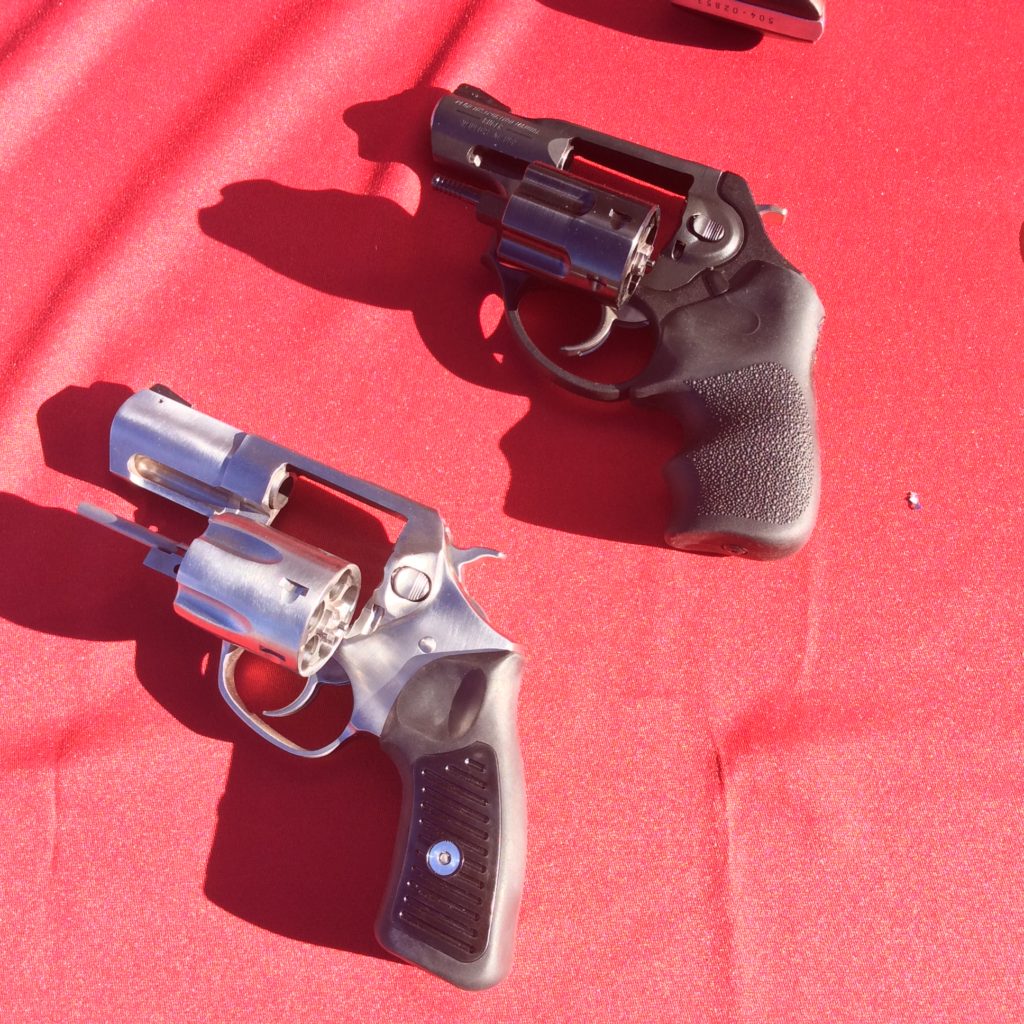
First, the 9mm LCR’s recoil was not objectionable. It was on par with .38+P loads in my all-steel 640 (with boot grips) and was definitely controllable. Second, although the steel-framed SP101 outweighed the LCR by a good bit (half again as much as the LCR—an extra 8 ounces), the hard rubber stocks on that gun made the experience less pleasant than shooting the LCR, with its excellent Hogue Tamer grip.
Armed with this knowledge, I obtained a 9mm LCR right away when I got home, and got busy shooting it.
Rounds Fired
In accordance with our RevolverGuy Field Test SOP, I fired a variety of ammunition brands and weights in the 9mm LCR, to include:
Lightweights
Federal 9BP, 115 grain JHP – 50 rounds
Federal 9BPLE, 115 grain +P+ JHP – 20 rounds
Freedom Munitions, 115 grain reman. FMJ – 9 rounds
Remington-UMC, 115 grain FMJ – 25 rounds
Winchester Silvertip, 115 grain JHP – 50 rounds
Winchester USA (“White Box”), 115 gr. FMJ – 75 rounds
Middleweights
CCI Blazer, 124 grain TMJ – 150 rounds
Federal HST, 124 grain +P JHP – 50 rounds
Miwall Corporation, 124 grain reload FMJ – 49 rounds
Sellier & Bellot, 124 grain FMJ – 100 rounds
Heavyweights
Federal HST, 147 grain JHP – 50 rounds
Total: 628 rounds
Reliability
Since the most important factor in a self defense gun is reliability, let’s start there. The 9mm LCR was 100% reliable with the factory loads from CCI, Federal, Remington, Sellier & Bellot (S&B), and Winchester, but I experienced two failures with the reloaded/remanufactured ammunition which are worth noting.
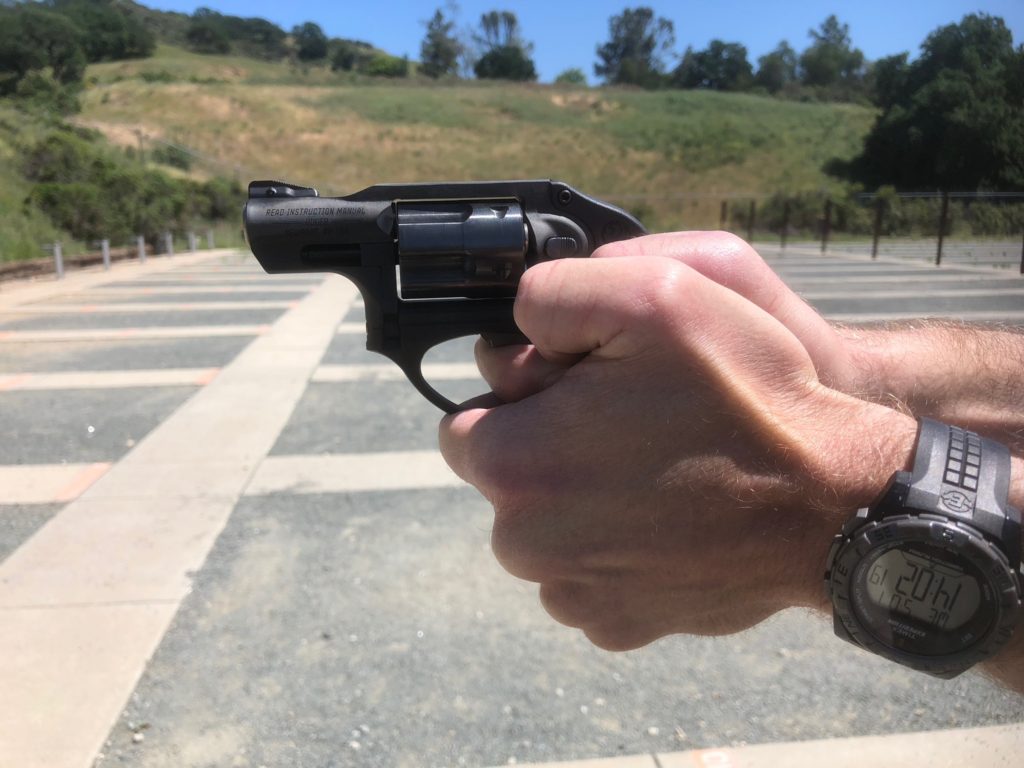
Those of you who reload ammunition know there are two basic ways to secure a bullet in a case. One method is to roll crimp the mouth of the case, so that it’s rolled inward and grips the bullet tightly at its crimping groove. The other is to taper the case, so that the flat sides of the case apply increasing pressure on the bullet as you near the case mouth. Roll crimping is more robust (so it’s commonly used in powerful revolver ammunition, like Magnum loads), but taper crimping is more commonly used on autopistol bullets, which often have straight-wall shanks that lack a crimping groove.
The reloaded/remanufactured ammunition I fired was assembled with a taper crimp, and in two cases, the crimp wasn’t robust enough to prevent bullet pull. To explain what I mean, when the gun begins to recoil, the resting inertia of the projectile makes it want to stay in place, as the gun (and therefore, the case) around it is thrust to the rear. With each round fired, the case is slowly pulled off the rear end of the resting bullet, and if the crimp isn’t good enough, the case can be pulled completely off the bullet as the chambers in front of it are fired.
This isn’t a problem in autopistols, because the rim of the cartridge is not engaged in the magazine, as it is in a revolver, and the entire cartridge is allowed to move back and forth inside the box magazine. Actually, in an autopistol, the bigger concern is having the bullet get pushed back into the case (either in the magazine, or when the projectile strikes the feed ramp during chambering), instead of getting “pulled” out. This “setback” can dramatically increase pressures, sometimes to unsafe levels.
So, in one instance where I was firing the first load in a multiple target, combat-type course, I fired 4 rounds on a pair of targets and moved to cover to reload. When I opened the cylinder and ejected the clip from the gun, I saw something fall from the cylinder after the clip was free, and felt a thump on my boot. Looking around, I found the clip with four fired cases and one unfired case, but the bullet was missing from the unfired case! A little more searching uncovered the pulled bullet, which had fallen out of the cylinder when I unloaded the gun.
The unburned powder grains made a mess all over my hand and underneath the extractor. It took a hand washing, and a bit of work with a toothbrush and patches from my cleaning kit to get things in working order again. I was glad I hadn’t pulled the trigger on that last chamber, because I might have wound up with a bullet stuck in the bore.
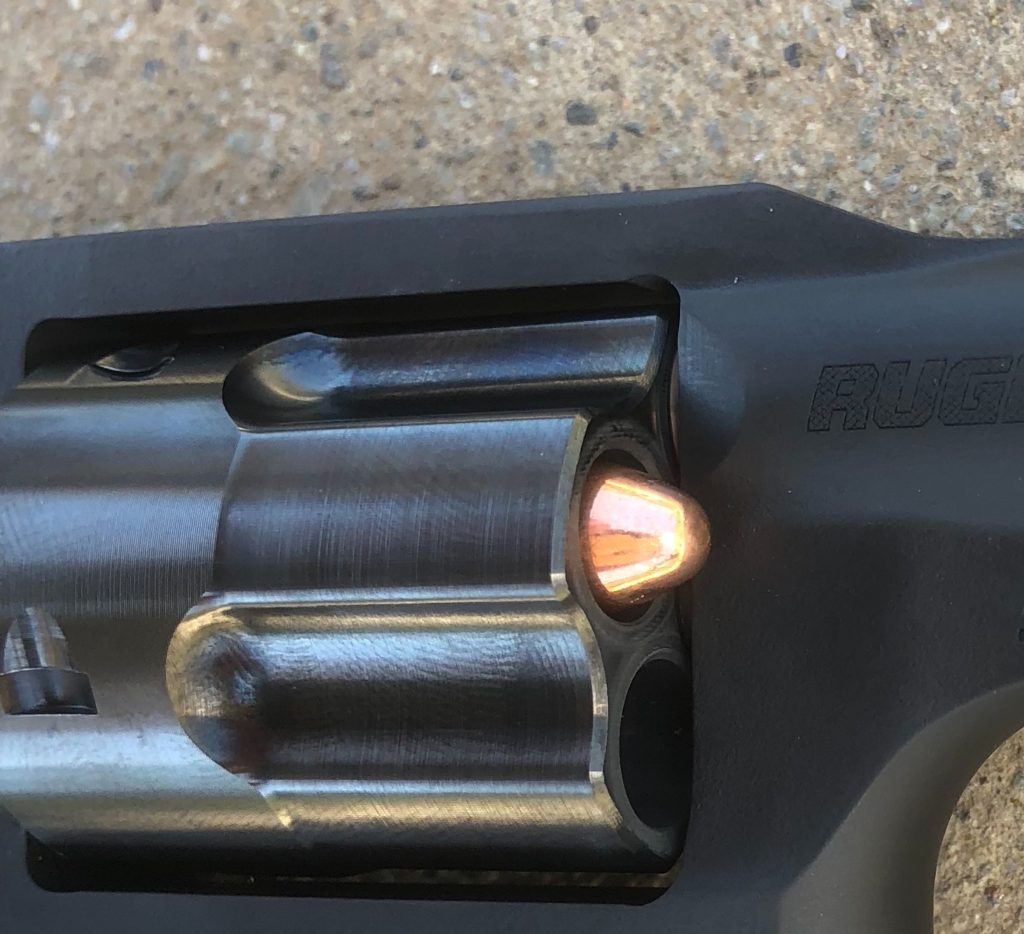
In the other instance, I was shooting the second load, and the bullet in the fifth chamber worked itself free and poked out the end of the cylinder. When I tried to pull the trigger on that last chamber, the cylinder wouldn’t turn, because its rotation was blocked by the protruding bullet. It took a few seconds to diagnose the problem, and once again, I was grateful I hadn’t pulled the trigger on that chamber with the bullet floating free from the case. After some photos, I poked the bullet back into the cylinder, and was able to open it and eject the clip. I was left with a loose projectile, a trail of unburned powder leading from the chamber, and another empty case with a virgin primer in it.
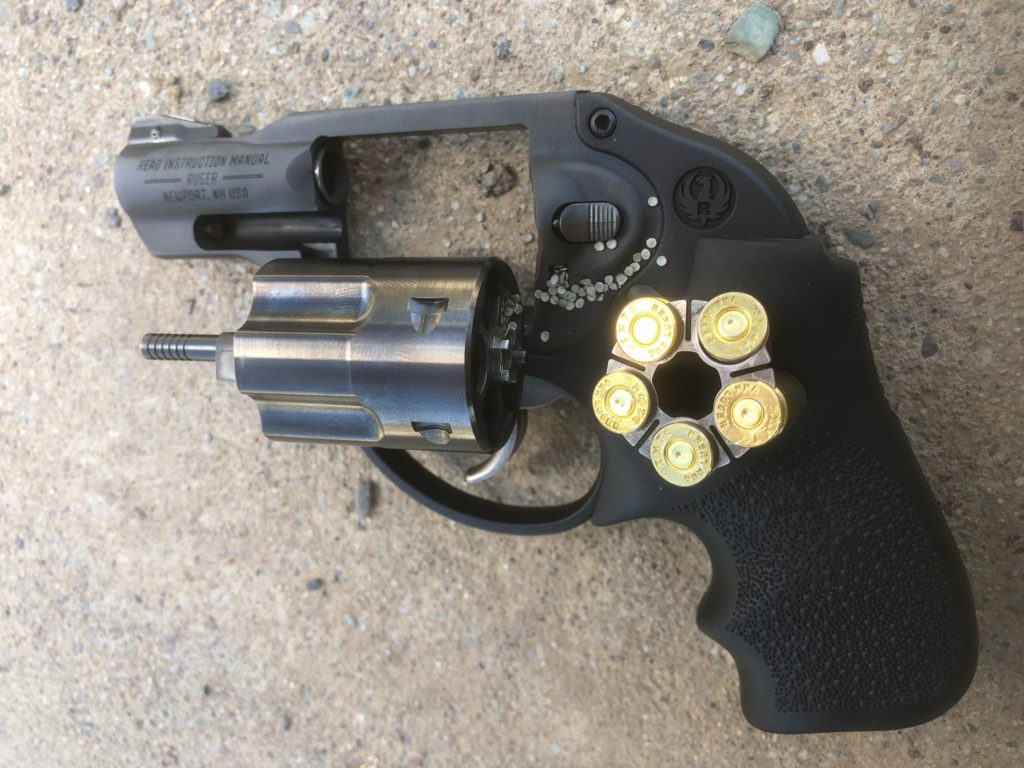
I need to emphasize these were NOT gun failures! The problem here is that the reloaded/remanufactured ammunition was not suitable for use in a revolver. The neck tension on the taper crimp was inadequate to prevent the ammunition from self-disassembling during the course of firing.
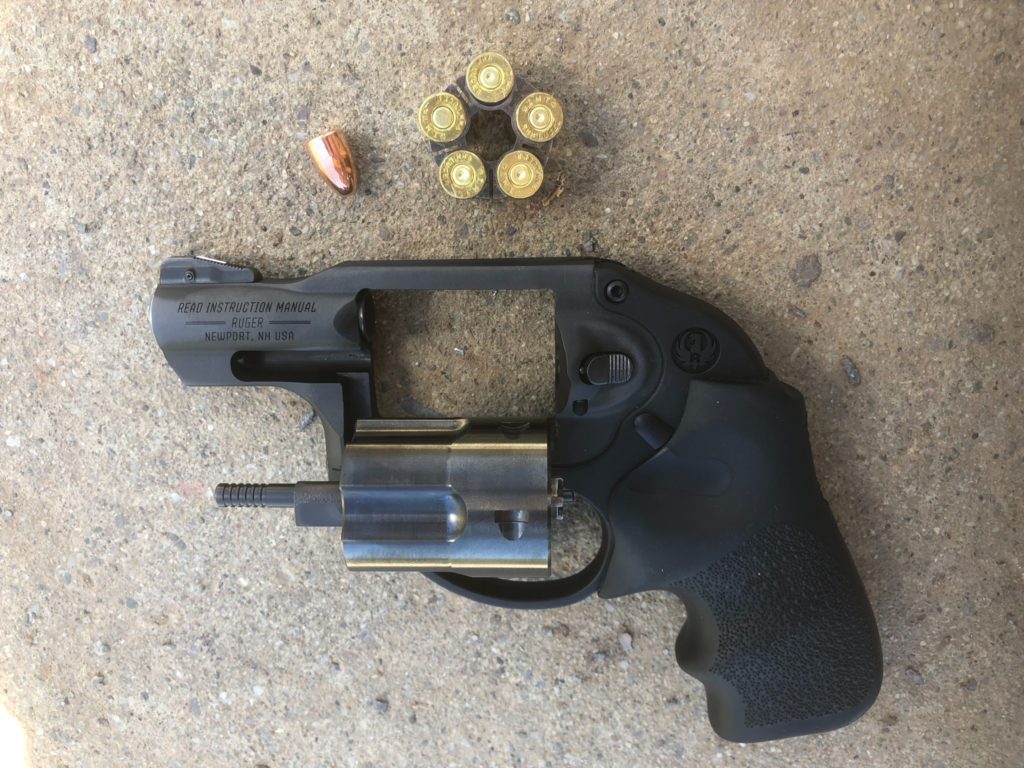
I did not have any problems with the factory-new ammunition coming apart like that. However, even the factory-new ammunition is susceptible to this phenomena, as indicated by a test I conducted. Picking the heaviest bullet weight I had (because the heavier projectile would encourage the most bullet pull), I miked a Federal HST 147 grain cartridge (1.126” OAL) prior to firing, and placed it as the number 5 cartridge in the gun. After firing the first 4, I pulled the number 5 cartridge and measured it again. The bullet had moved 0.042 inches (1.168” OAL) forward under the effects of recoil, and I could now see the cannelure on the bullet’s shank.
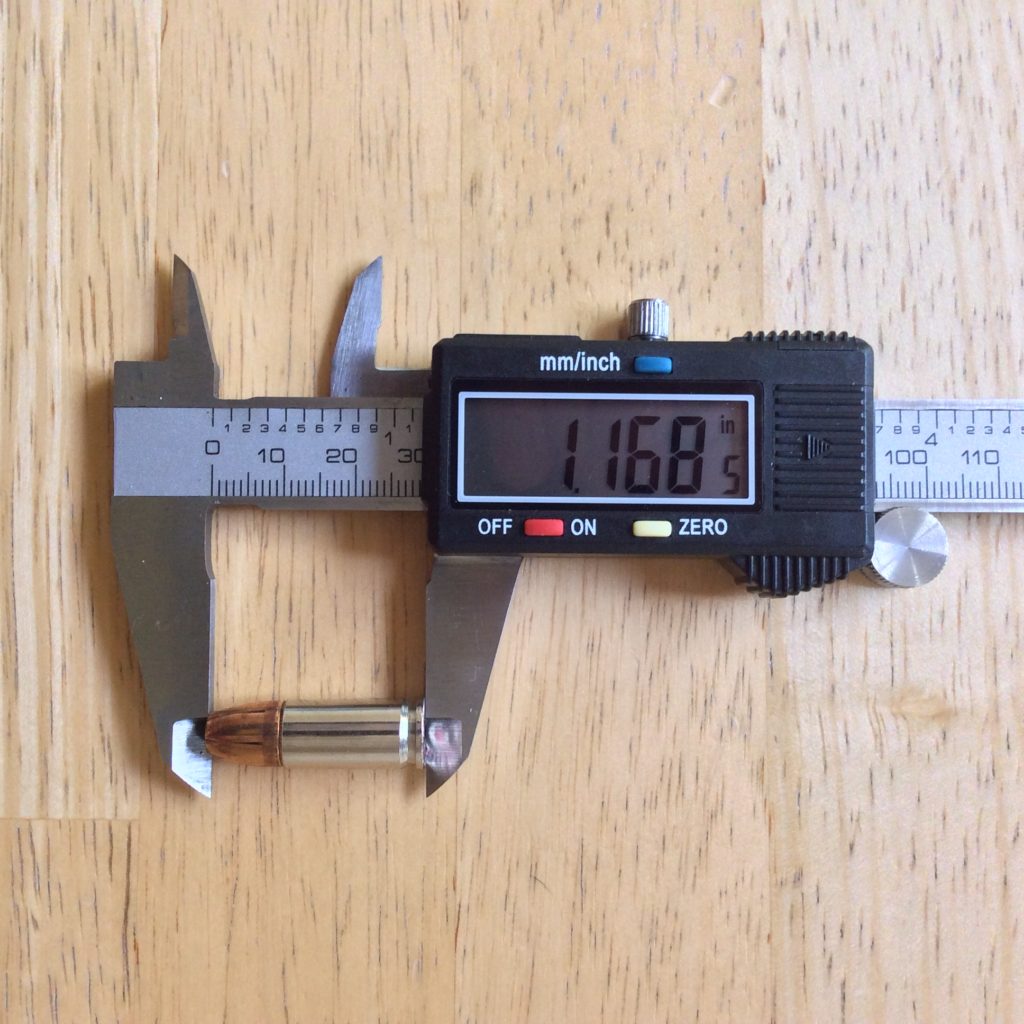
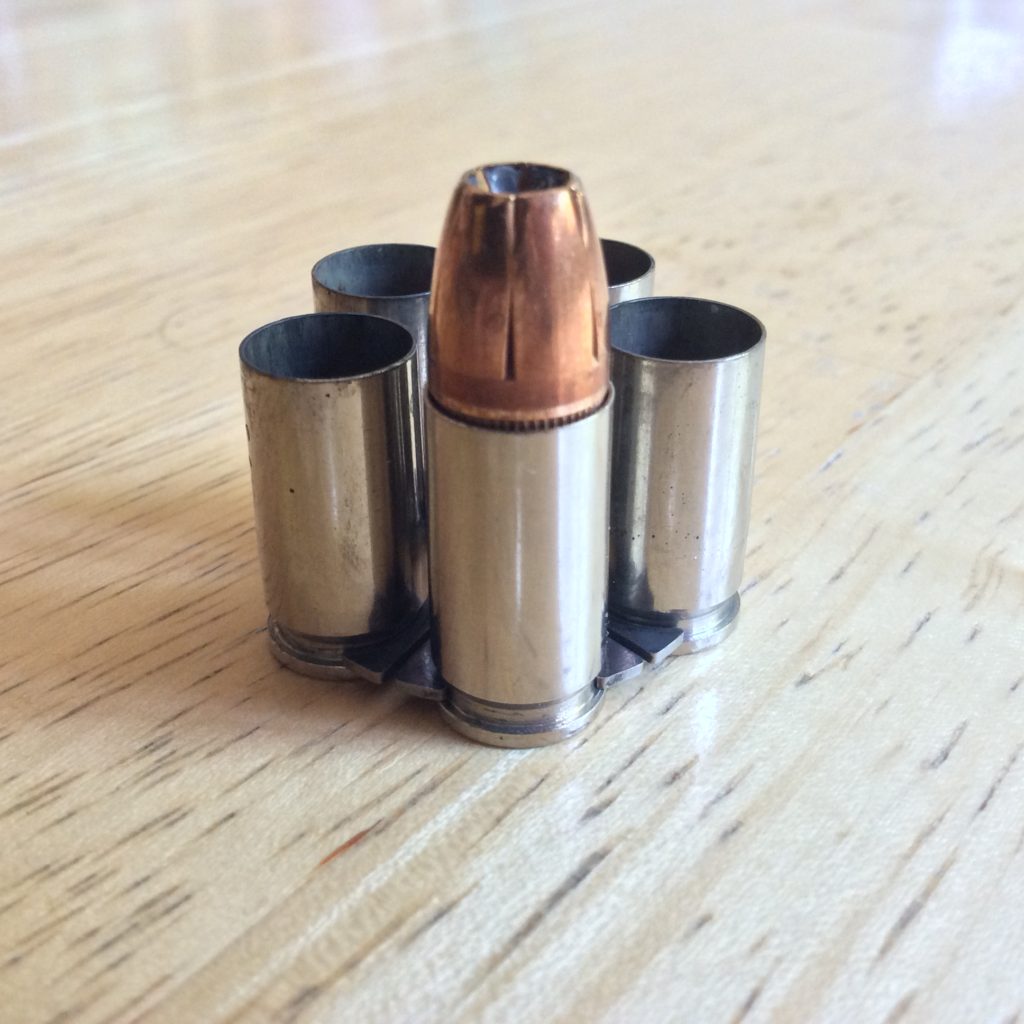
Bullet pull is a real phenomena, and one you must be concerned with when picking ammunition for your 9mm revolver. The factory-new ammunition I tested suffered no failures, and the LCR was completely reliable when it was fed with suitable ammo, but the crimp on the commercially reloaded/remanufactured ammunition just wasn’t good enough to withstand the effects of recoil in the metric Ruger.
As such, for safety and reliability, I strongly recommend against using reloaded/remanufactured ammunition in the 9mm LCR (and other clip-fed revolvers), and I also encourage shooters to carefully test the duty ammunition they have chosen for their 9mm revolvers. Shoot enough of your duty ammunition (I would say 100 rounds minimum, with no failures) to ensure that you won’t have issues with bullet pull jamming up your lifesaving tool.
One other reliability issue concerns the full moon clips that hold the cartridges. Ruger supplies three of these with the gun, and they work very well. The 0.032” thick clips are easy to load and unload with your fingers, and don’t require a lot of pressure to seat or remove a case. However, they do have a limited lifespan. By the time I fired around 450 rounds with these 3 clips, 2 of them had a single “chamber” that lost tension. I’m guessing that I bent the fingers while unloading the clips, so the notch opened up.
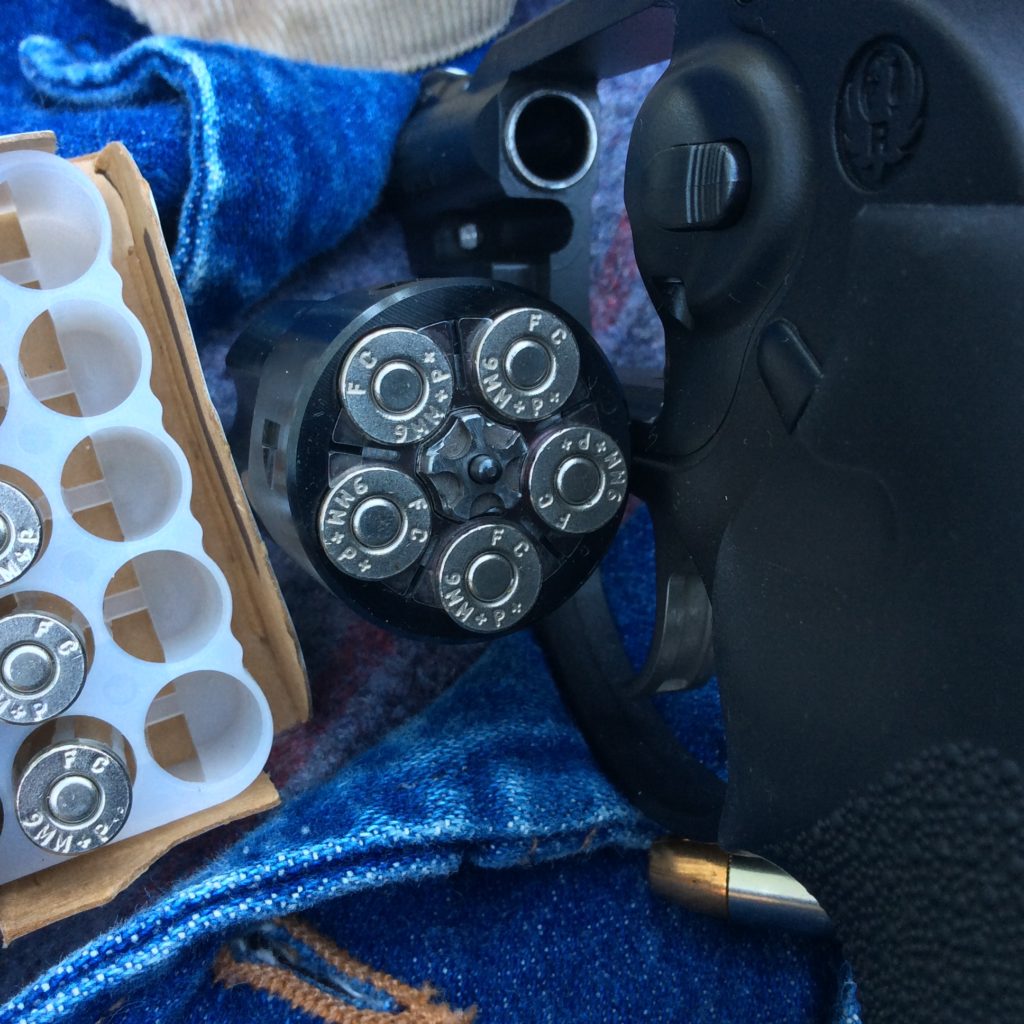
The clips were usable if you took some care to seat them in the cylinder, but the fingers of the clip didn’t hold the one cartridge tightly enough to ensure it would stay in place when carried in a pouch or pocket. I was able to insert a knife blade into the gap between the fingers and spread them back apart, restoring the clip for additional use, but within another 100 rounds, the tension was off again. Fortunately, a 3-pack of replacements is only $15 plus shipping on ShopRuger.com, and Speed Beez is selling a 10-pack of their 0.030” thick clips, plus an unloading tool, for $36 plus shipping. I would heartily recommend using some care when “de-mooning,” and having some spares handy to keep your gun running.
Speaking of clips, you can actually fire the 9mm LCR without them, by placing the cartridges straight into the chambers. The cartridges will headspace on the case mouth and will fire without drama (100% reliable in my testing). Getting them out might be a little more tricky though, because the extractor has nothing to grab onto, to pull them out. I found that simply inverting the gun would cause the cases to fall out about 60% of the time (even the hotter 115 grain +P+ stuff would free fall, to my surprise) but the rest of the time you had to pull them out with your fingernails, or poke them out from the front of the cylinder. In a pinch, you could reload your LCR from a pistol magazine if you had to, but I wouldn’t plan on doing it a second time with any kind of efficiency or speed.
Controls
The cylinder release on the LCR is classic Ruger, with a push button that seems to work well for both left and right handers. Although I’m habituated to the sliding thumb piece on the Smith & Wessons, it took no reprogramming to operate the Ruger’s control, which worked perfectly every time for me.
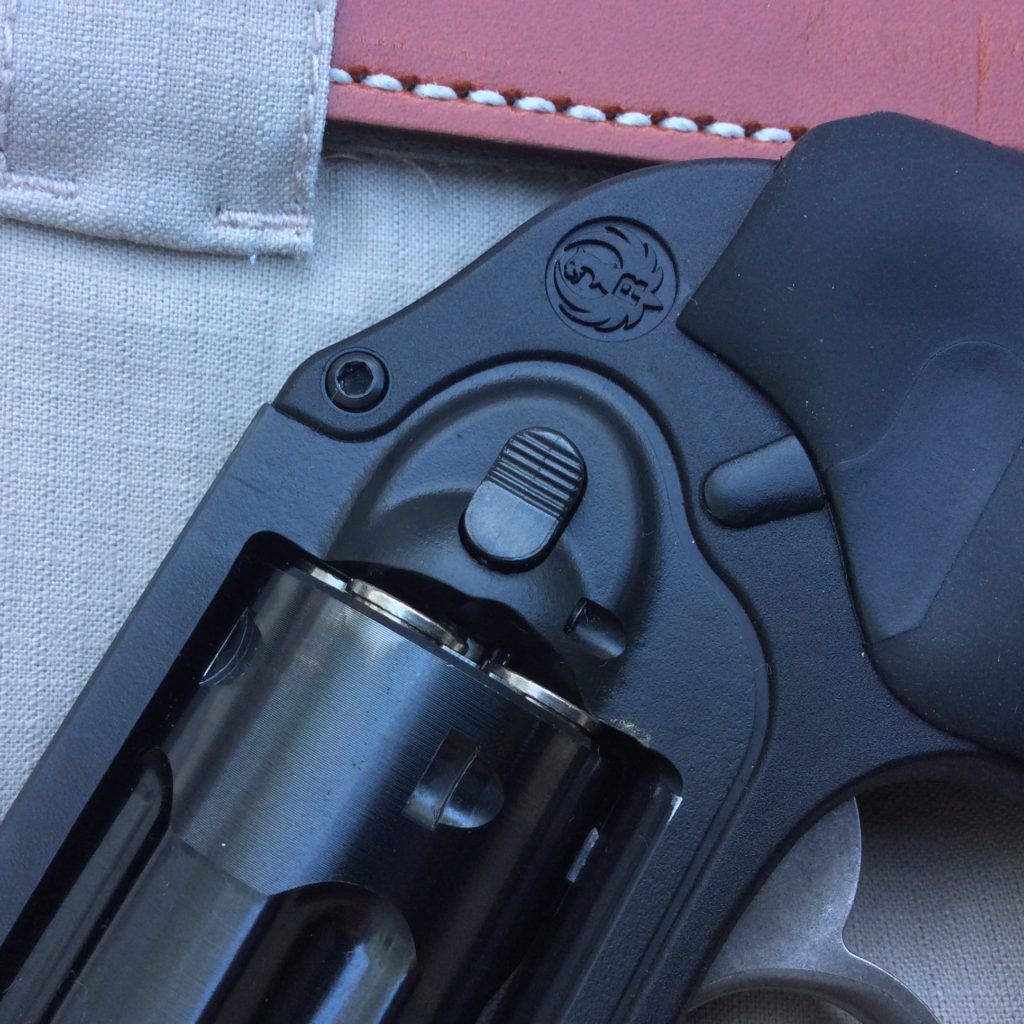
One thing about the Ruger release that I appreciated is that it didn’t chew up my shooting hand thumb knuckle as much as the S&Ws do. The combination of a small gun with compact stocks, a large hand (with long, thin digits), and my unique grasp all but guarantees that my thumb knuckle will get cut at some point by the cylinder release. I’ve tried smoothing the edge of the thumb piece on my S&Ws, adjusting my grasp, and different stocks, but have never found a solution that solved the problem without creating bigger ones, so over the years I’ve just accepted the fact that I’m going to get bitten when I shoot small guns like this.
The Kimber K6s was the first gun in this class that treated me well, and it was nice to shoot a gun that didn’t make me bleed. The LCR fell somewhere in the middle between the Kimbers and the Smiths—it cut me a little, but didn’t grind my thumb like the Smiths do. I suspect that a little attention to the bottom edge of the Ruger’s release with a stone could go a long way towards eliminating my problem entirely, and will eventually give that a try.
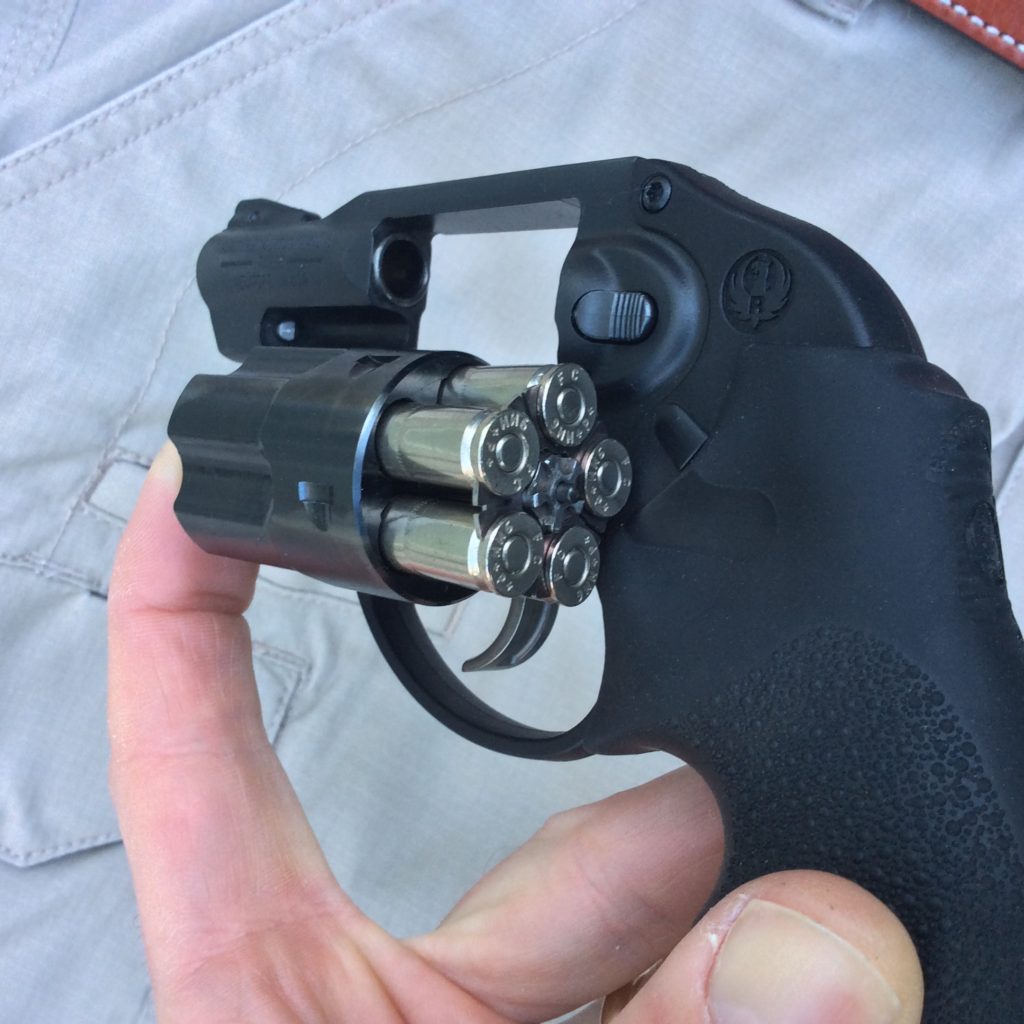
The ejector rod throw on the LCR is more than sufficient to clear the stubby 9x19mm cases at (approximately) 0.616 inches. That puts it in the same territory as my .38 Special 640 (0.620 inches), even though the Special’s case is much longer than the Parabellum’s. In all the shooting I did with the 9mm LCR, I never had a single instance of spent cases getting hung up in the cylinder—that full moon clip really helps to guarantee reliable ejection.
Grips
The Hogue Tamer grips on the LCR are impressive. I attribute the LCR’s soft shooting personality almost entirely to these excellent grips, which cushion the hand very well against the recoil of this lightweight blaster. I normally stock my small revolvers with boot-style grips that are optimized for concealment. These have open backstraps and offer little grasping surface, so the larger Hogue Tamers felt like a guilty pleasure on this snubby—there was much more to hang onto, which improved my control of the gun. The cushioned rear of the grips really did tame the effect of the recoil, making the 9mm lightweight shoot softer than my heavier, all steel, boot-gripped, S&W 640 with some .38+P loads.
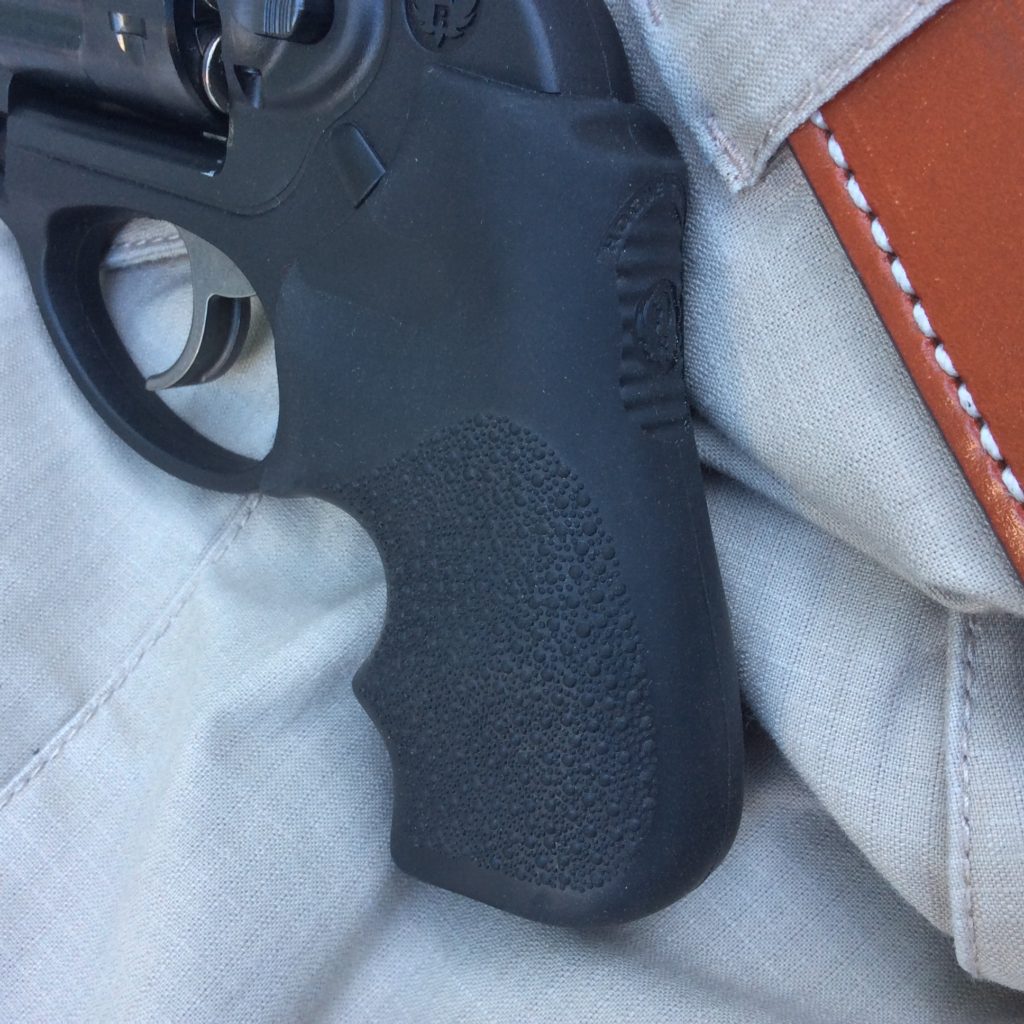
The Tamer grips concealed well enough in AIWB carry, but weren’t ideal for pocket carry. The tacky rubber grabs material, and the profile of the grips is too large for most pockets. Fortunately, Hogue makes a different style of grip that’s better suited for pocket carry—the Bantam / Boot Grip. The Bantam is a smaller grip, and the sides are smooth plastic, to prevent them from catching on clothing. The front and rear still have the soft rubber material that cushions recoil so effectively on the Tamer design. I’ve purchased a pair of these, and will test them on the LCR in the near future.
TRIGGER
The trigger on the LCR is probably my favorite thing about the gun. I previously described the engineering behind the LCR’s trigger design and won’t go into it here, but I will say that I’m exceptionally impressed with the result.
The LCR’s double action trigger has a very small amount of creep before engagement, followed by a smooth and linear pull that peaks around 9 pounds on my sample (factory specs are 8 – 14 pounds on the centerfire LCRs, but other gunwriters report 9mm LCR values ranging from 8.5 to 9.5 pounds on their guns). For those who like to “stage” their double action triggers, there’s a place you can do it near the end of the stroke, but I found that it was easy to just roll through the trigger from start to finish and get excellent results.
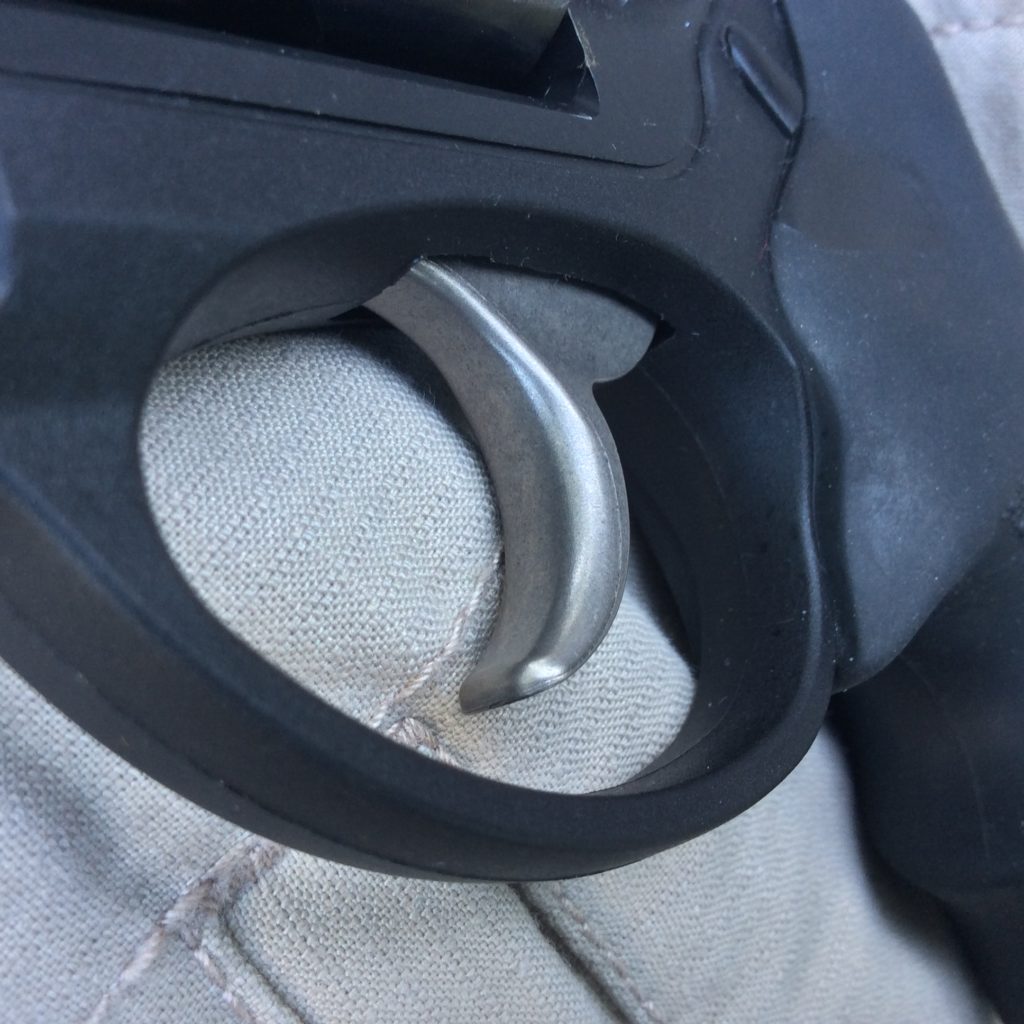
The trigger face is nicely rounded, with no grooves and no square corners to irritate your finger. Your trigger finger can roll across the smooth, rounded surface when the trigger pivots, just like it’s supposed to. I had to pay a gunsmith to make my S&W 640 trigger look and feel like this, so I really appreciate the fact that Ruger built it into the design from the start. Excellent.
My only real complaint about the trigger is the sluggish reset. The mousetrap-style spring that powers the trigger return on the LCR isn’t near as robust as the coil spring that powers the rebound slide on a J-Frame, so the LCR trigger doesn’t reset forcefully like the Smith does. A shooter who’s habituated to the S&Ws may find themselves short-stroking the LCR trigger at first, because there’s not much tension to fight and there’s a small bump in the return that can fool an untrained finger into believing that the trigger has reset. This is especially likely when shooting fast—the LCR’s return spring just doesn’t pop the trigger forward with authority, and you can easily outpace the action if your trigger finger has had its coffee today.
The good thing about the lighter spring is that it contributes to the LCR’s lighter weight of pull, which is several pounds less than the equivalent, factory J-Frame. Also, after a bit of practice, you’ll get into the LCR groove pretty quickly, and your finger will learn to let the trigger travel fully forward before starting it on a return journey to the rear.
It’s not perfect, but it’s a darned good trigger, especially for a mass production gun. You can do some great work with it, as we’ll see later.
Sights
I liked the sights on the LCR much better than the standard sights on my J-Frame revolvers. The LCR’s front sight is wider (0.128” versus 0.113” on my S&W 640) and so is the rear notch (0.153” versus 0.122” on the 640). The bigger notch allows more light (improving acquisition and clarity) and the wider blade is easier to find, particularly because it’s marked with a bright white insert. The tight window provided by a J-Frame’s rear sight can really make it a chore to get a good sight picture, particularly when the front and rear sights are the same color/material (as they are on just about every non-“Pro” model), but this task is much easier with the LCR’s bolder and friendlier sights.
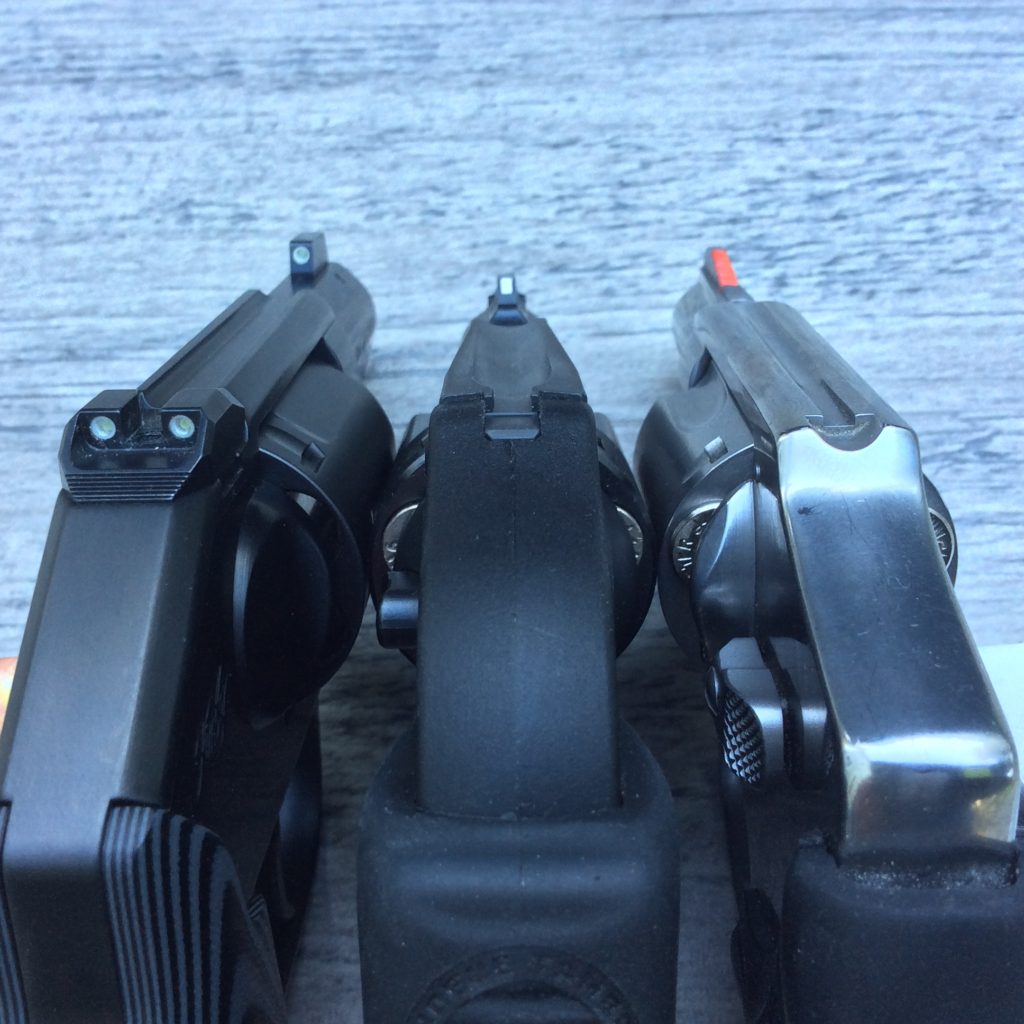
The Kimber K6s sights still handily trump the LCR sights when it comes to the quality of the sight picture, but the Ruger’s sights are actually better regulated than those on the more expensive competitor.
My experience with the 9mm LCR is that it shot some brands of 115 grain ammunition (Winchester and Remington ball) to point of aim up to 7 yards, and other brands (Winchester Silvertip, and Federal 9BP and 9BPLE) shot as much as 2 inches below the point of aim out to 10 yards. In the 124 grain weight, CCI ball shot about 1.5 inches low at 7 yards, S&B ball shot about 2-3 inches low at 7 yards, and Federal’s excellent 124+P HST was a laser beam, shooting at or slightly below point of aim out to 10 yards. The heavyweight 147 grain HST was also a flat shooter, hitting right at the point of aim out to 10 yards.
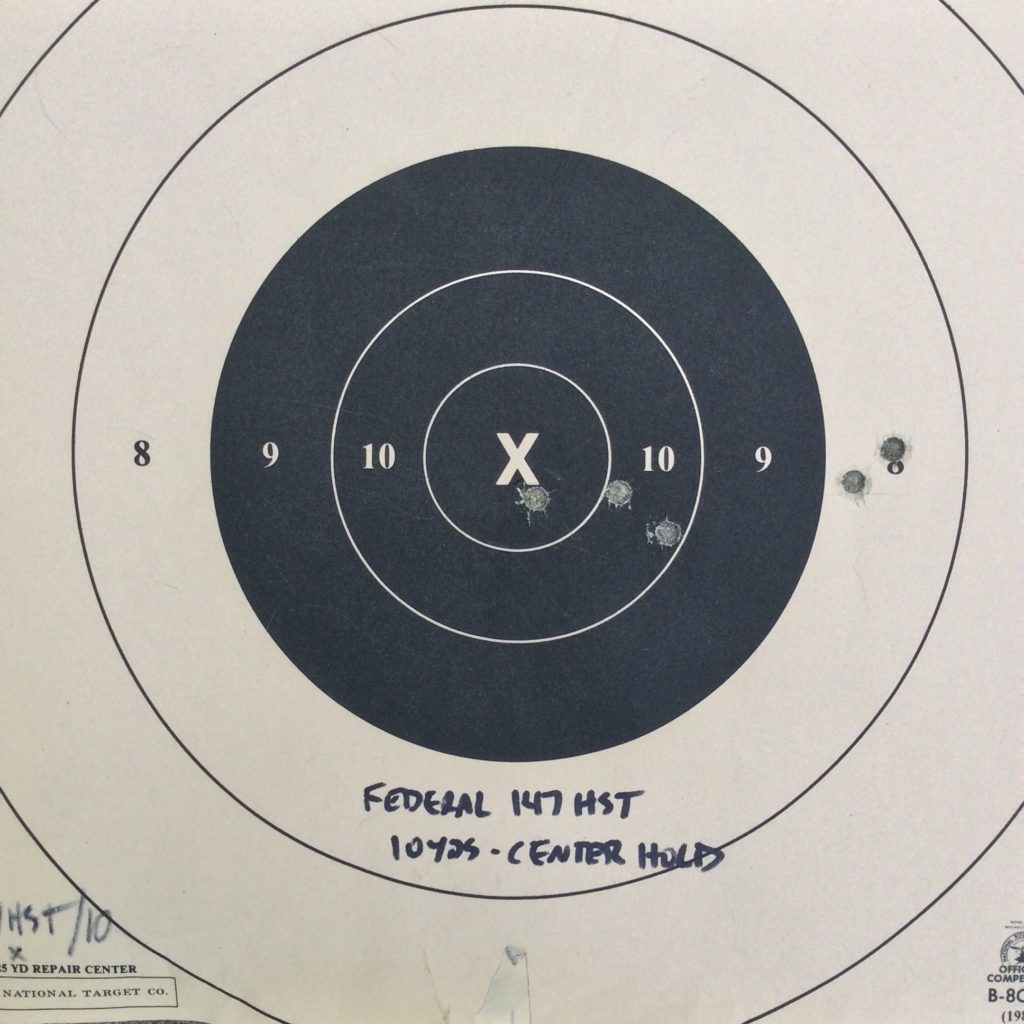
I didn’t print the gun on paper at longer distances, but I did shoot some steel at 25 yards and 50 yards and was surprised by this gun. Using a mix of Federal 9BP 115 grain JHP, 124+P HST, and 147 HST, I was able to ring steel consistently at the longer ranges. The 25 yard targets were MGM Target’s Half-Scale IPSC targets, mounted at a 30 degree angle from the vertical (which made them appear even smaller). If I planted the front sight right in the middle of the silhouette, I got hits with all bullet weights. At 50 yards on full size IPSC targets, holding in the center earned me some hits too, but my misses were going over the top, so I probably needed to hold a bit lower.
Despite that, I couldn’t have been happier about the sight regulation on this gun. After a disappointing experience with sight regulation on the much more expensive Kimber K6s, it was really refreshing to see the little Ruger put its rounds right where the sights said they would go, inside of 25 yards.
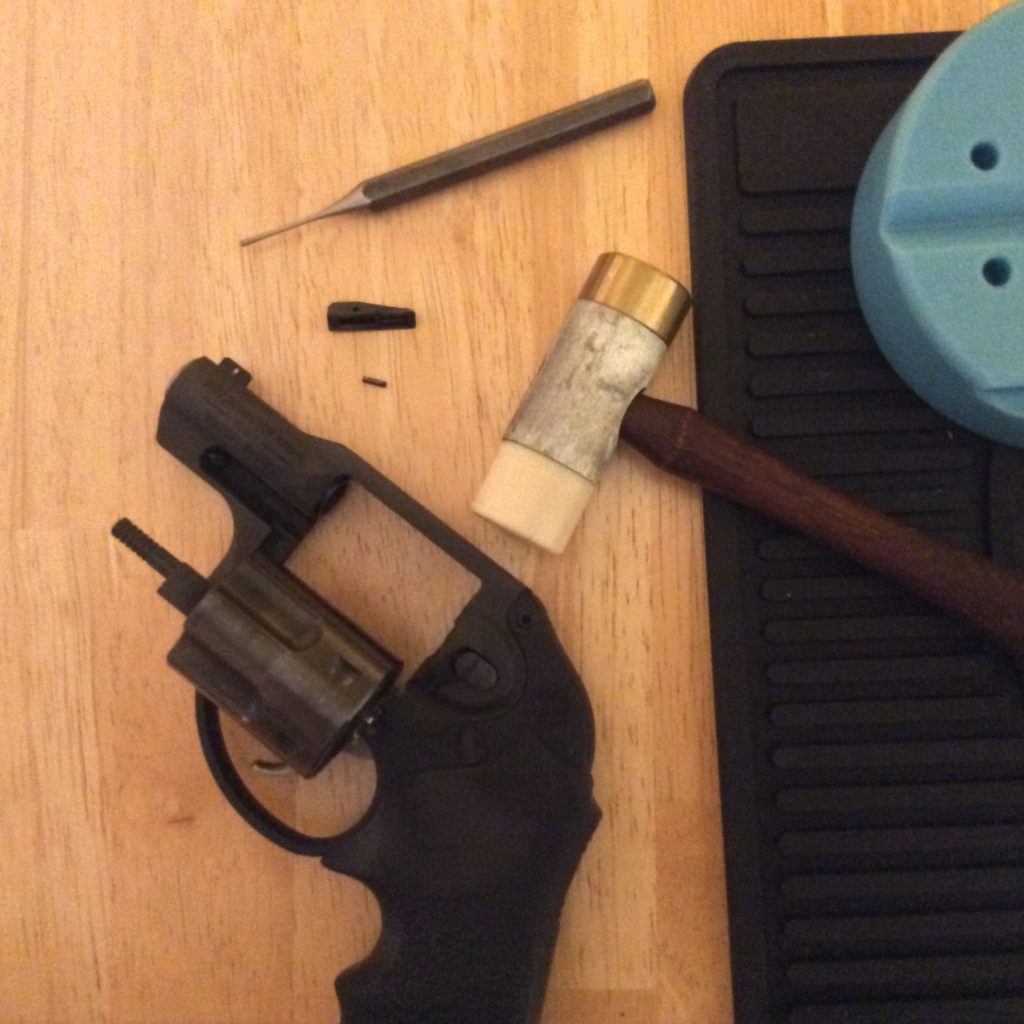
The front sight on the LCR is pinned, which allows the user to replace it pretty easily with another blade. This is a significant improvement on the standard J-Frame front sight, which is integral to the barrel and not replaceable. Unfortunately, approaching 500 rounds, I discovered the pin had walked out a little on the blade on my LCR, and the front sight wiggled back and forth, plus or minus 5 degrees from center. Simply drifting the pin back into place did not eliminate the wobble in the front sight, so other measures were required to true things up.
I removed the roll pin which secured the front sight and covered the underlying post with a few layers of painter’s tape to take up the slop between the post and the cavity under the front sight body. I then reinstalled the front sight body and roll pin, which removed the play in the front sight. The sight and roll pin stayed where it was supposed to for the next 100+ rounds, but I’ll be keeping an eye on it in the future. There may come a day when I’ll need to replace that roll pin with one that fits tighter.
Accuracy
The RevolverGuy Field Test SOP calls for compact guns to be tested at 10 yards, so that was the primary distance I shot on paper. All rounds were fired from a two-handed, unsupported, standing position.
The 9mm LCR did a great job when I did my part. You’ll see that I struggled with trigger control on some of the targets, landing some of the groups left of center, others to the right. I actually shot better groups on small 1.5” circles than I did on the much larger 25 yard repair centers. I think this is mostly because I had a hard time finding the center of the big black bull with the black sights on the LCR, but there may have been an element of “aim small, miss small” at play as well.
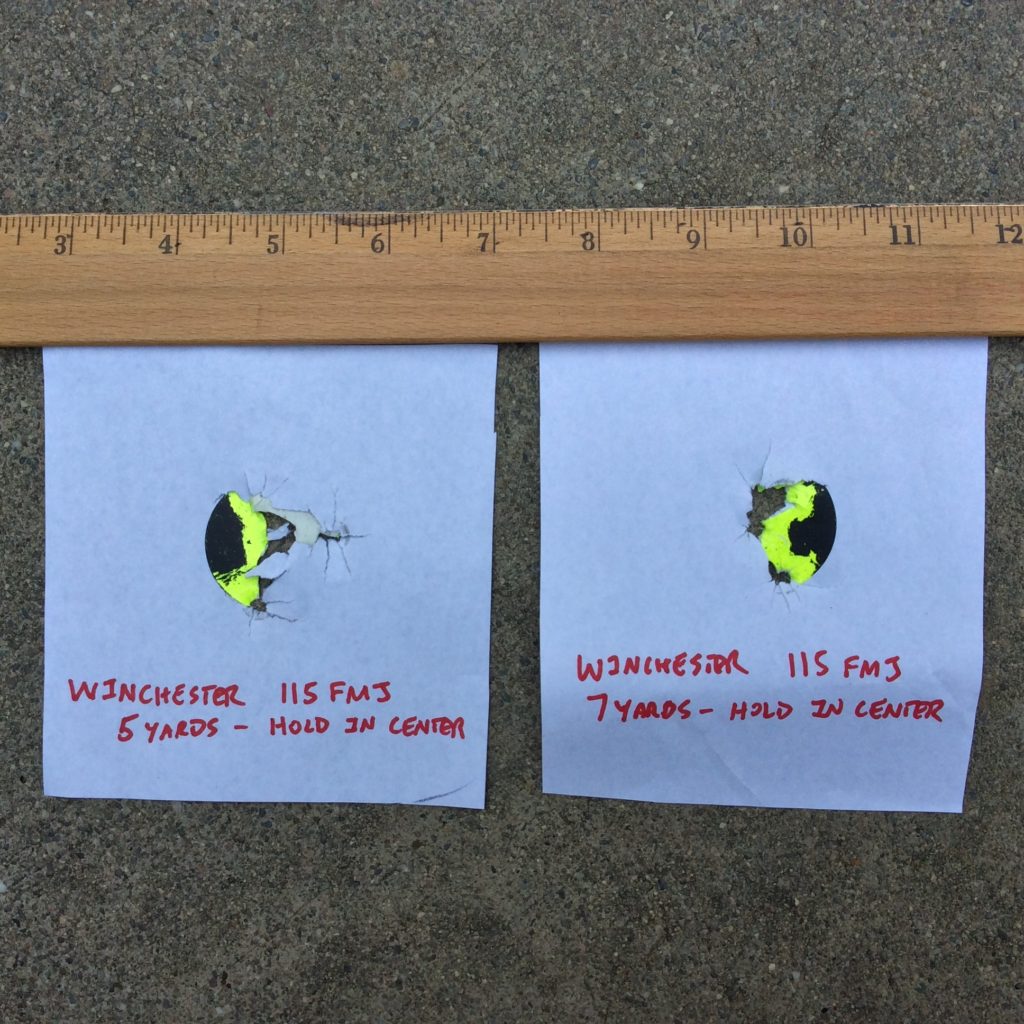
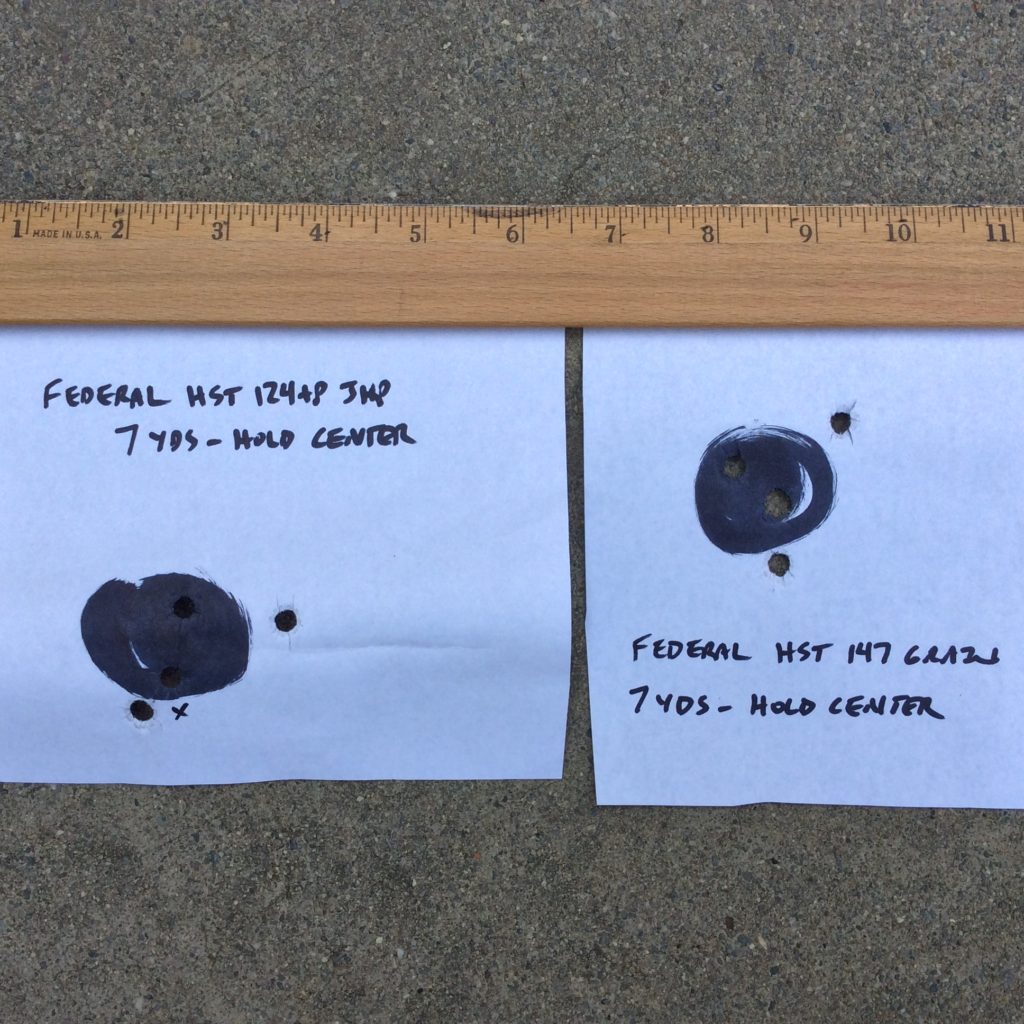
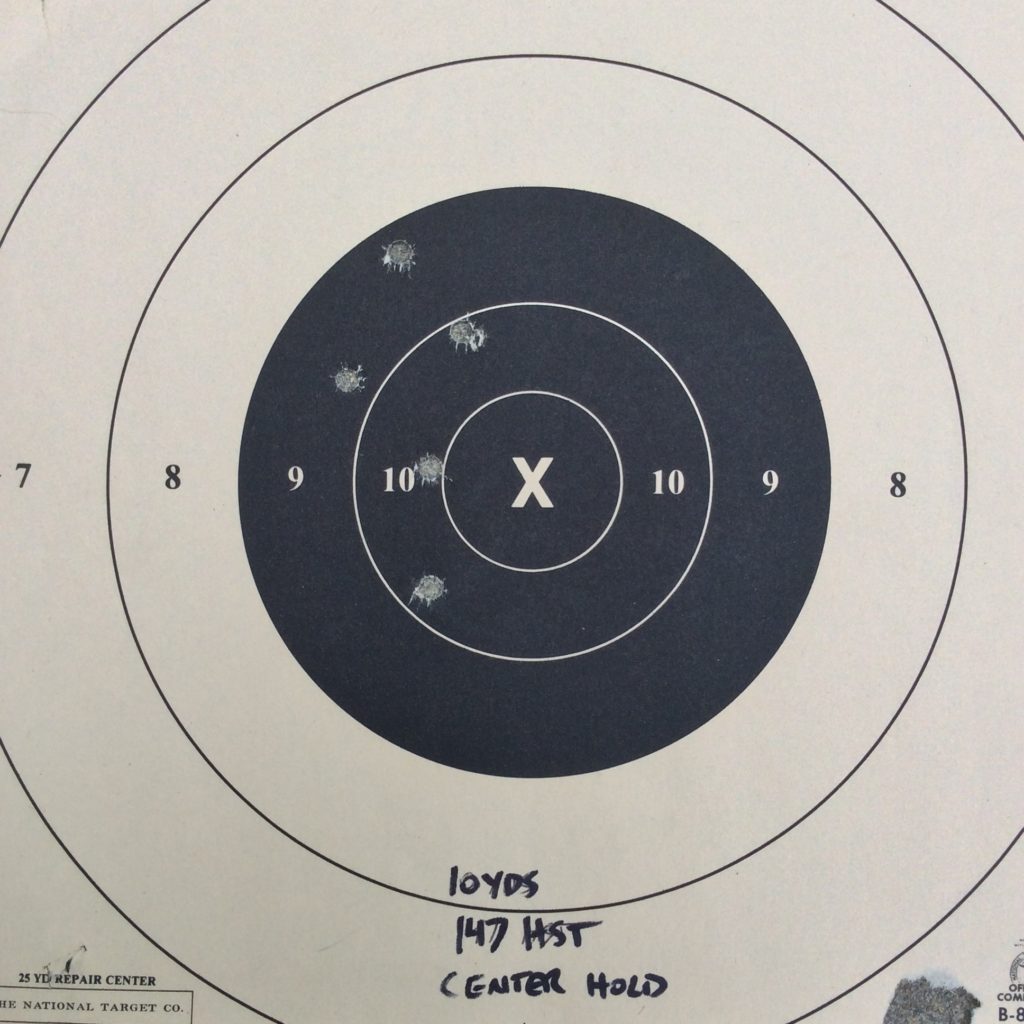
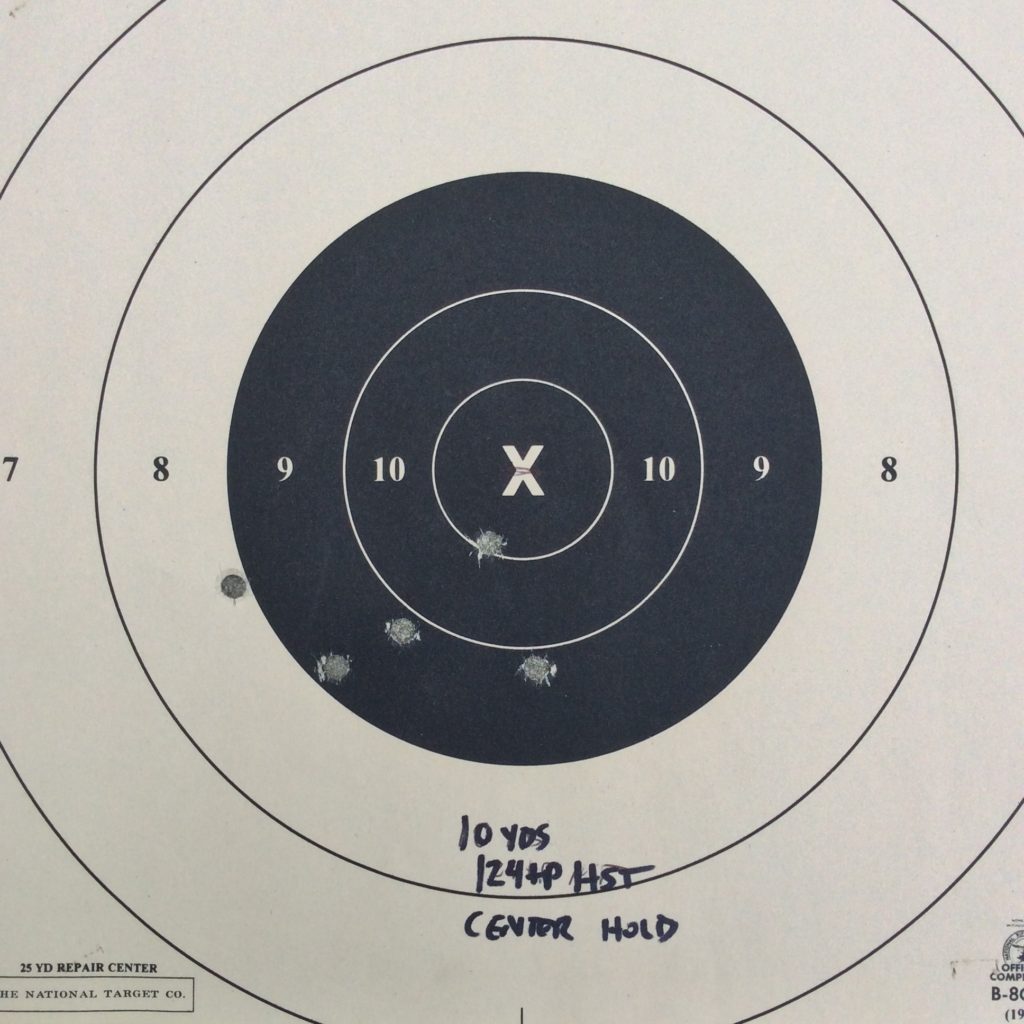
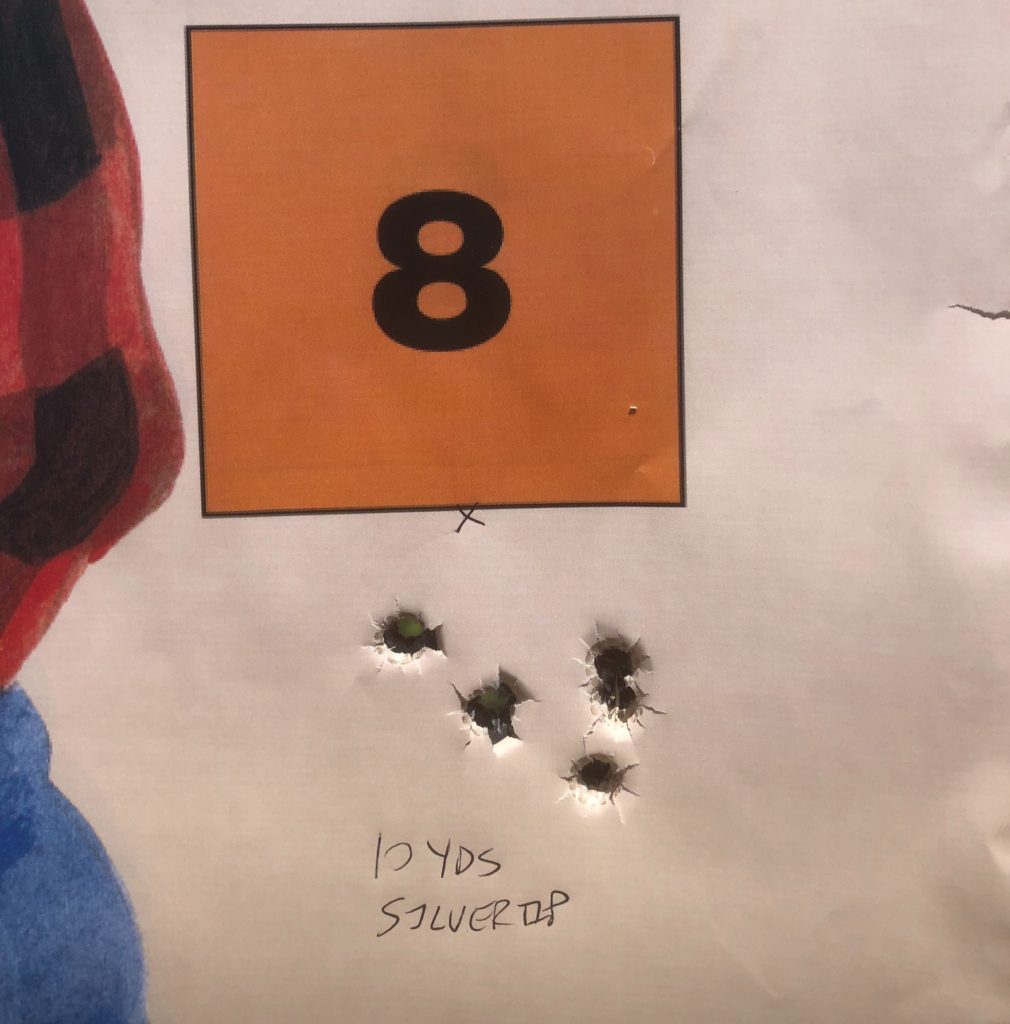
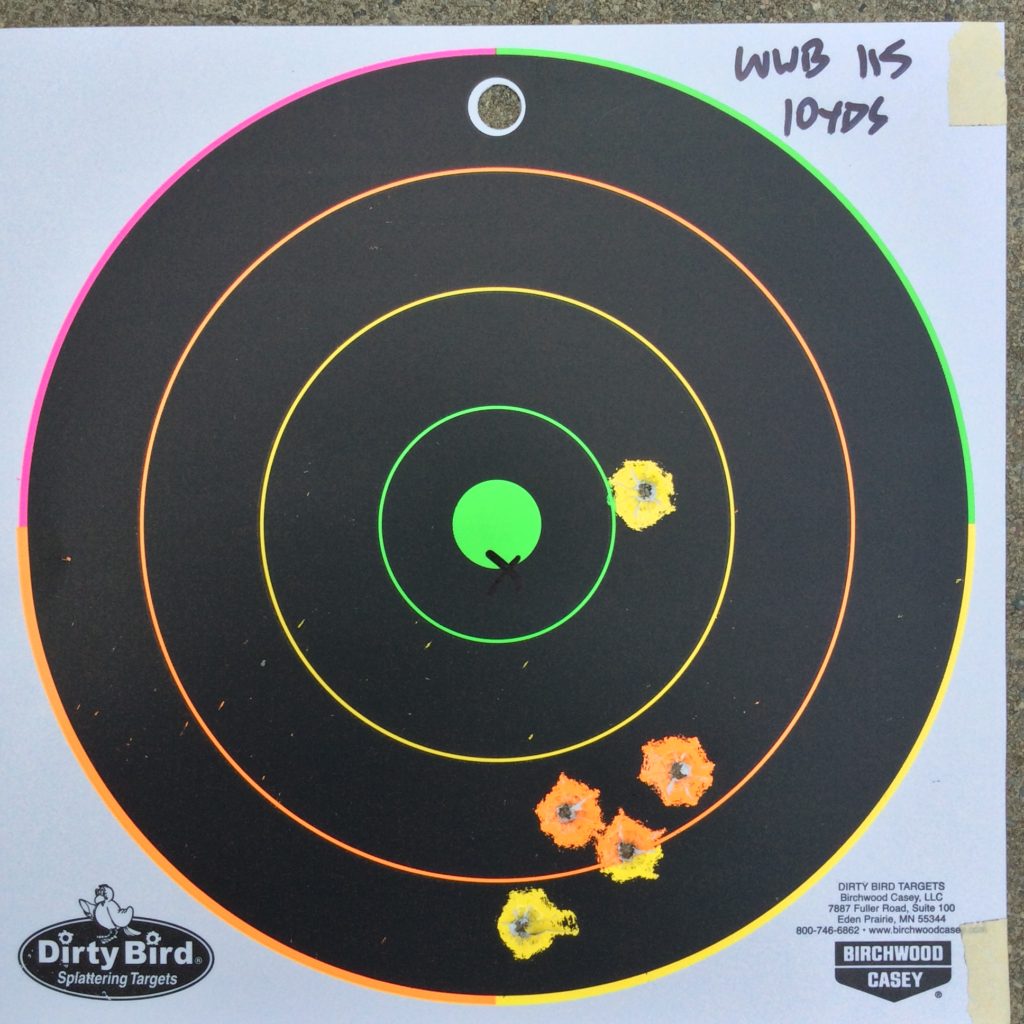
I mentioned the steel previously, and I have to return to that for a second. At 25 yards, I could hit the half-scale IPSC targets 5 for 5, but when I pushed out to 50 yards, I was hitting 2 or 3 out of 5 (probably because I was holding too high for the distance). Frankly, I was rather stunned by this level of practical accuracy. I don’t think I could have done this with my boot-gripped Model 640, and I think it speaks highly of the 9mm LCR that I was able to turn in this kind of performance.
The RevolverGuy SOP calls for two runs of Dot Torture, and I obliged. In my first run, I was shooting the CCI Blazer 124 grain TMJ, which printed a good inch below the sights. This meant I had to aim at the top edge of the dots, obscuring the target, to sink my rounds inside the border. The range I was shooting at forced me to have a go at 5 yards, which is a little far to start Dot Torture, but it’s all I could do. My score of 43/50 wasn’t bad for the first try, but I knew I could do better.
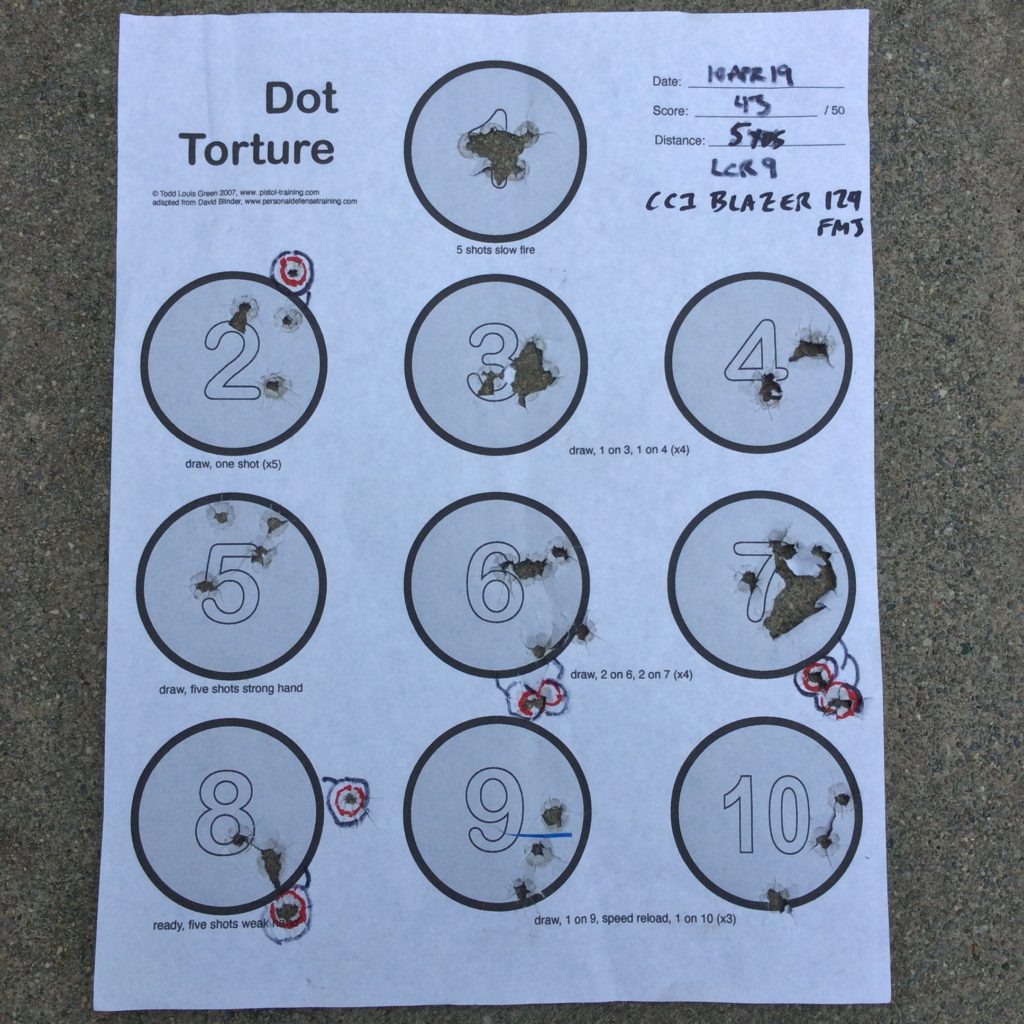
The second round of Dot Torture near the end of testing was shot on an outdoor range with gusty winds pushing the target frame back and forth. I did a pretty good job of timing the gusts, but on the third stage, Mother Nature played some tricks on me. One gust pushed the top of the target frame forward about 10 inches as I was shooting, and another gust pushed it back 10 inches when I shot the other round in the pair. Both rounds went outside the circle and I decided to give myself an alibi and shoot that pair over again. I threw one round on the weak hand only stage, and earned a final score of 49/50, shooting a mix of the flat-shooting 124+P HST and 147 HST at 4 yards distance.
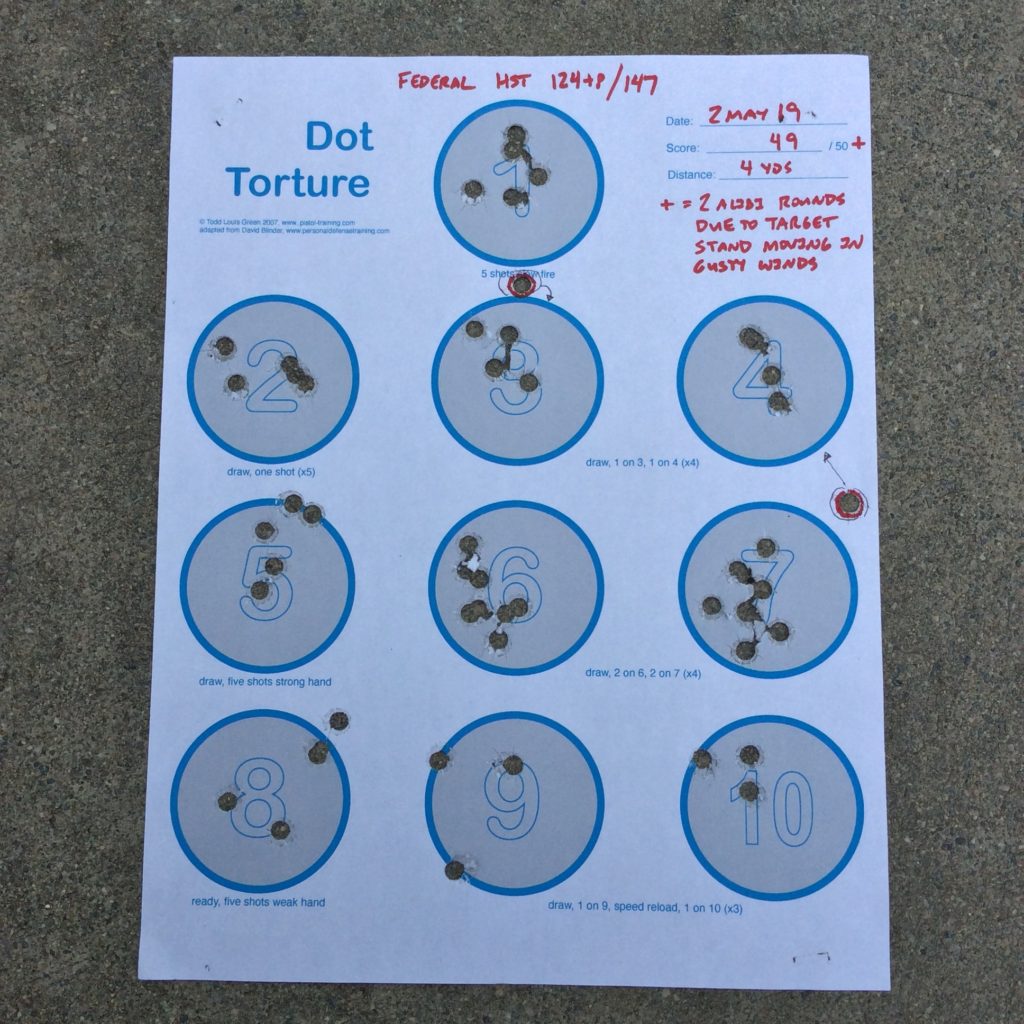
The gun will definitely do its part, if you do yours.
I didn’t mention it anywhere else, but the full moon clips make short work of reloading the gun. The stubby, 9mm cartridges seem to find the chambers all by themselves, and the whole process of recharging the gun seems to be easier than working with longer revolver cartridges in a speedloader. I especially enjoyed the fact that there are no grip interference issues to contend with.
Carrying the LCR
I carried the LCR a little bit in pocket holsters from Aker and DeSantis, but the Hogue Tamer grips were just a little too big to pull it off in most pants and shorts. The deep pockets of some cargo pants were the best home for the pocket holsters.
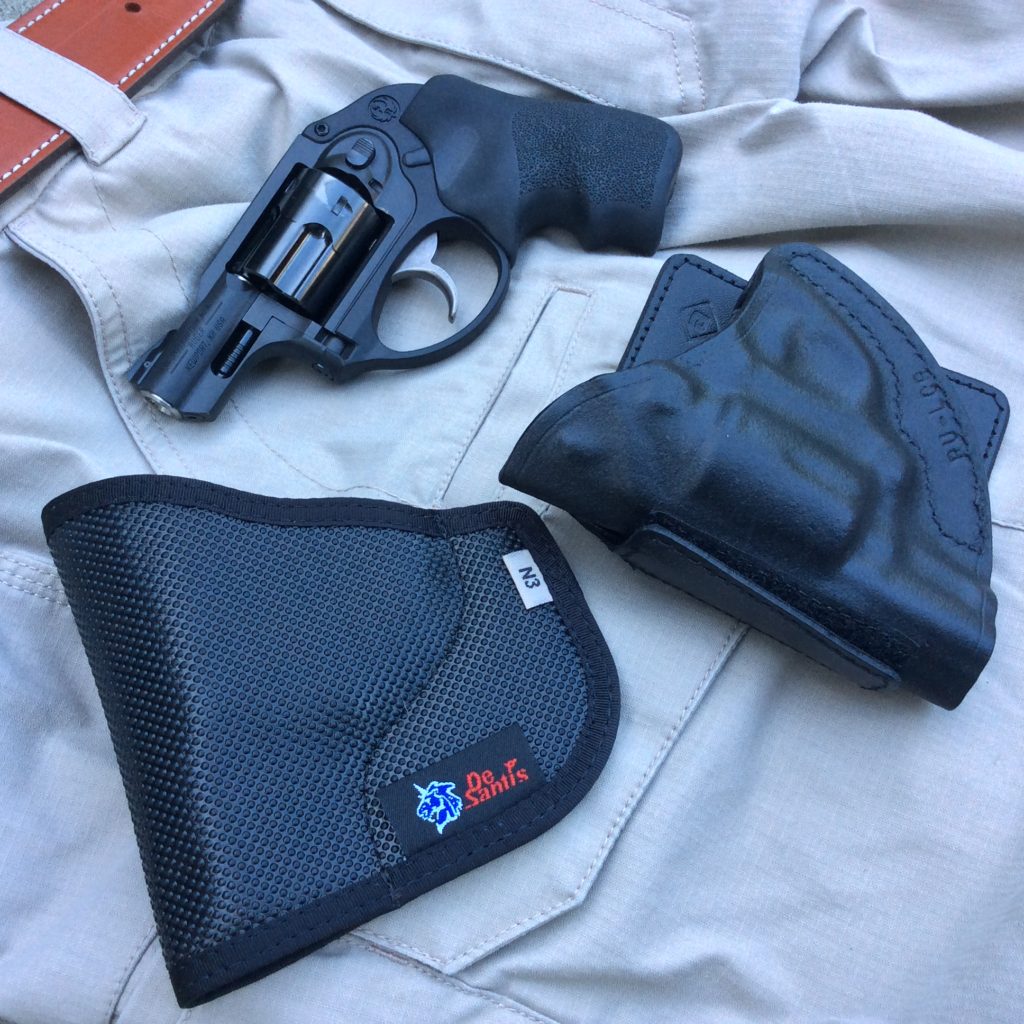
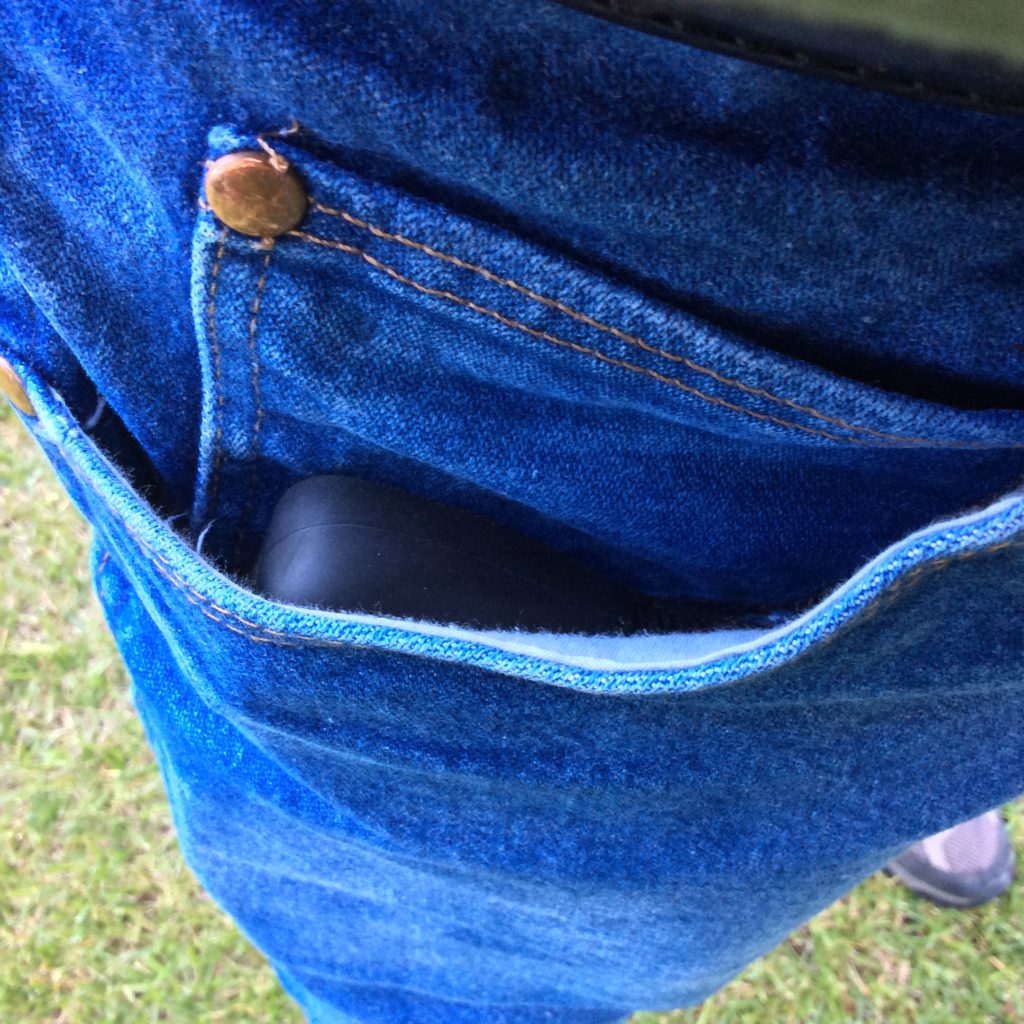
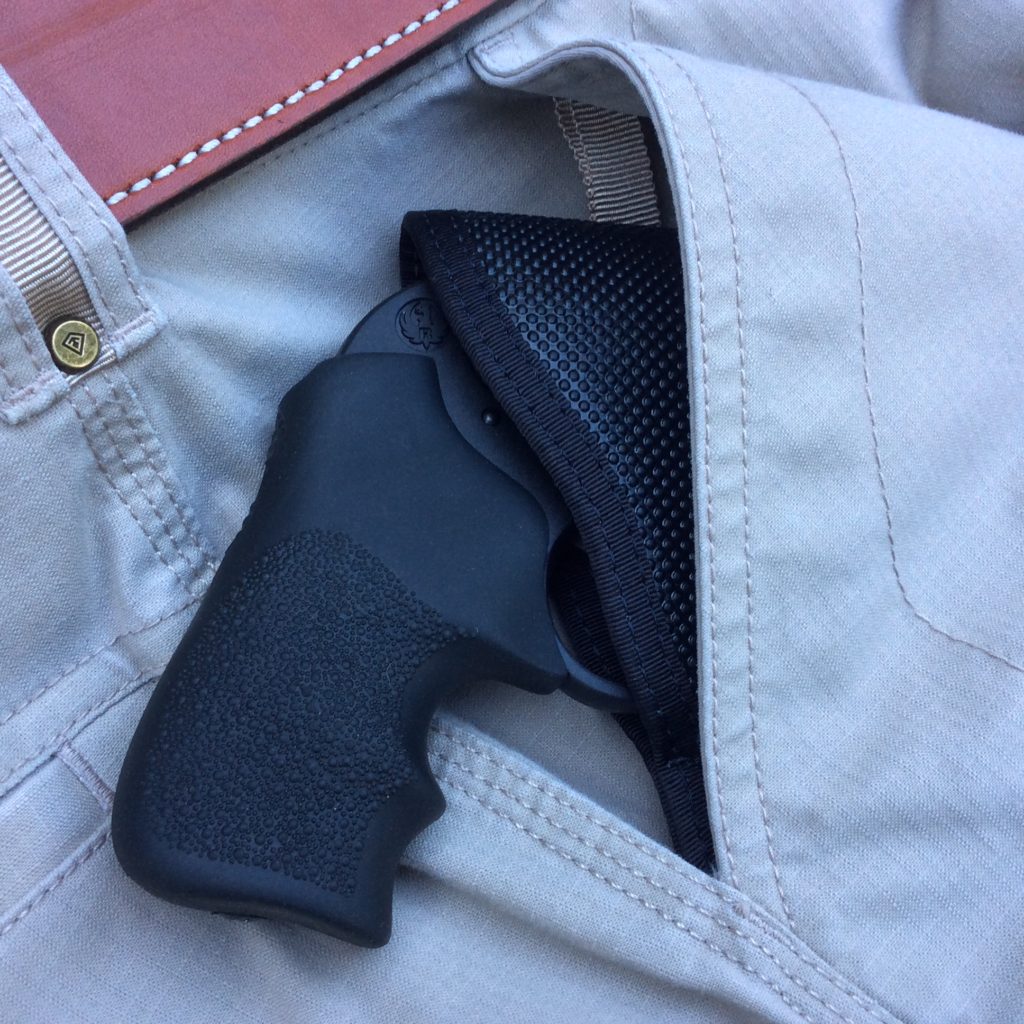
Most of the time, I carried the LCR in an Aker Model 134 Spring Special, which is an open top, IWB holster with a spring clip. Unlike the Aker Model 160A that I previously reviewed (and liked), the Model 134 is made from very thin material, which allows the holster to collapse when the gun is removed. There is a reinforced band around the holster mouth that keeps it from totally collapsing, but the entirety of the holster body below the band slams shut when the gun comes out. The workmanship on the holster was good, but I don’t care for holsters that follow this pattern and don’t plan to use it again, now that the test is complete.
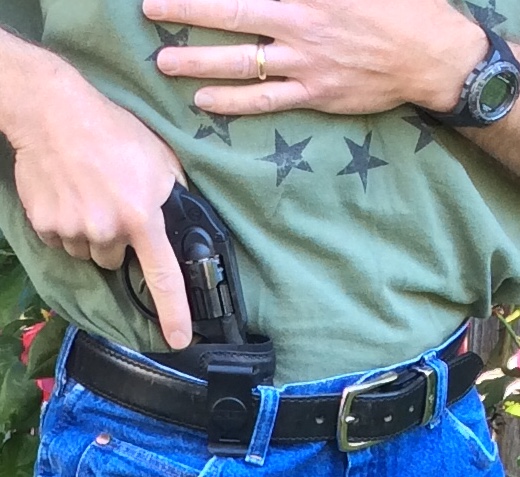
On the plus side, the Model 134 did allow me to test the LCR as a carry gun. I found that the lightweight LCR was a joy to carry, and the smooth, snag-free design was easy to get into action. Since the LCR has proven to be worth the effort and investment, I’ll be ordering a better holster to carry this little gun, and will report on it in these pages at a later date.
One thing about a clip-fed revolver is that it’s a little more complex to carry a reload. The clips can get bent if you toss a loaded one loose into a pocket, so you need a carrier for them. There are some carriers that incorporate a post to stack the clips on, but they seemed to be more oriented towards a competition environment, than a concealed carry one. There are also pocket carriers and a variety of quality pouches you can use, but I was looking for something a little different.
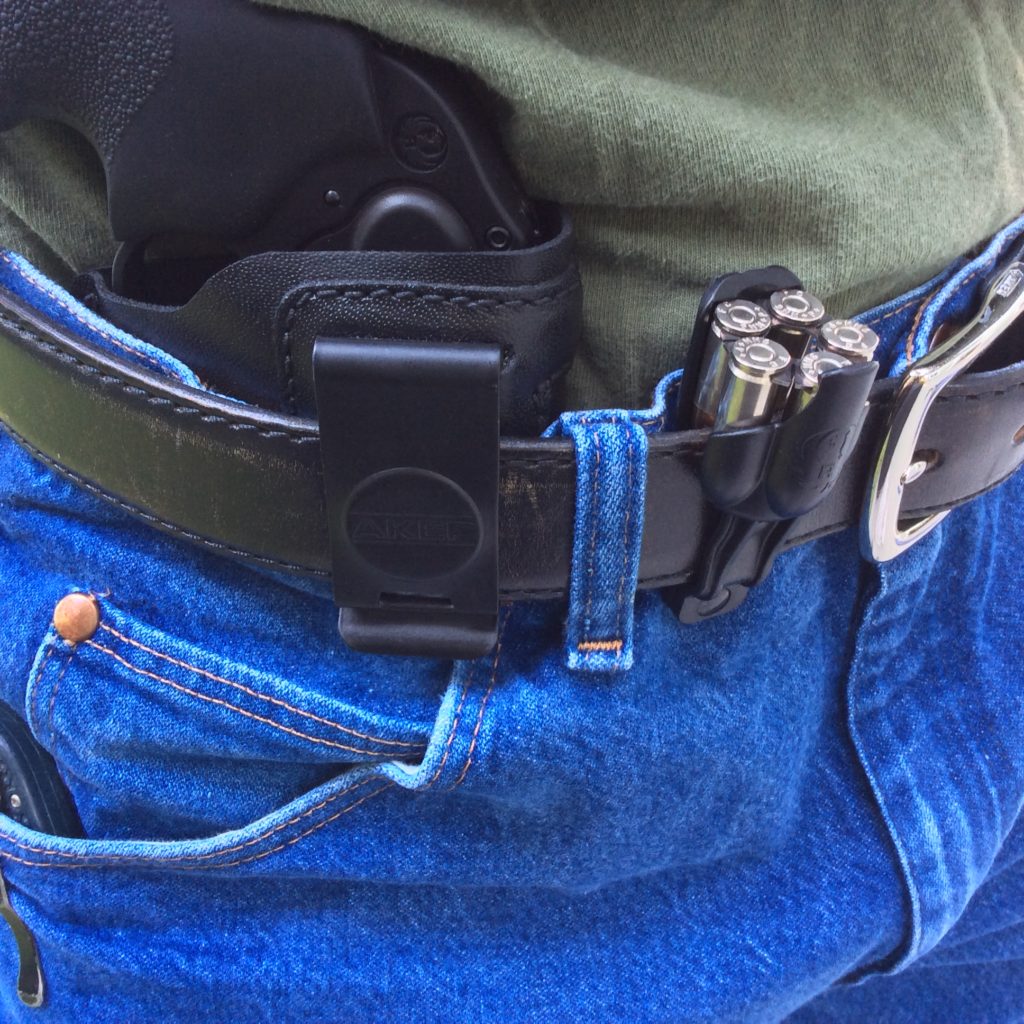
I eventually discovered the Bill Rogers design, which is both affordable and compact. The Rogers-designed carrier—now available through ShopRuger—is reminiscent of the “split six” speedloader carriers, and is simply a plastic clamshell that holds the clip in its open jaws. After working with it, I discovered the Rogers design has some quirks. First, it can be a real pain to don the clip/carrier over your worn belt—my suggestion is to put the clip in the loader first, then thread it onto your belt. Second, the carrier doesn’t allow a straight up, out the top draw, like you’re used to with your speedloader carriers. Instead, you open the jaws of the carrier and free the clip by rocking it out sideways. This was a little awkward at first, and I was afraid I’d bend the clip by applying too much force, but with some more practice I got it to work OK.
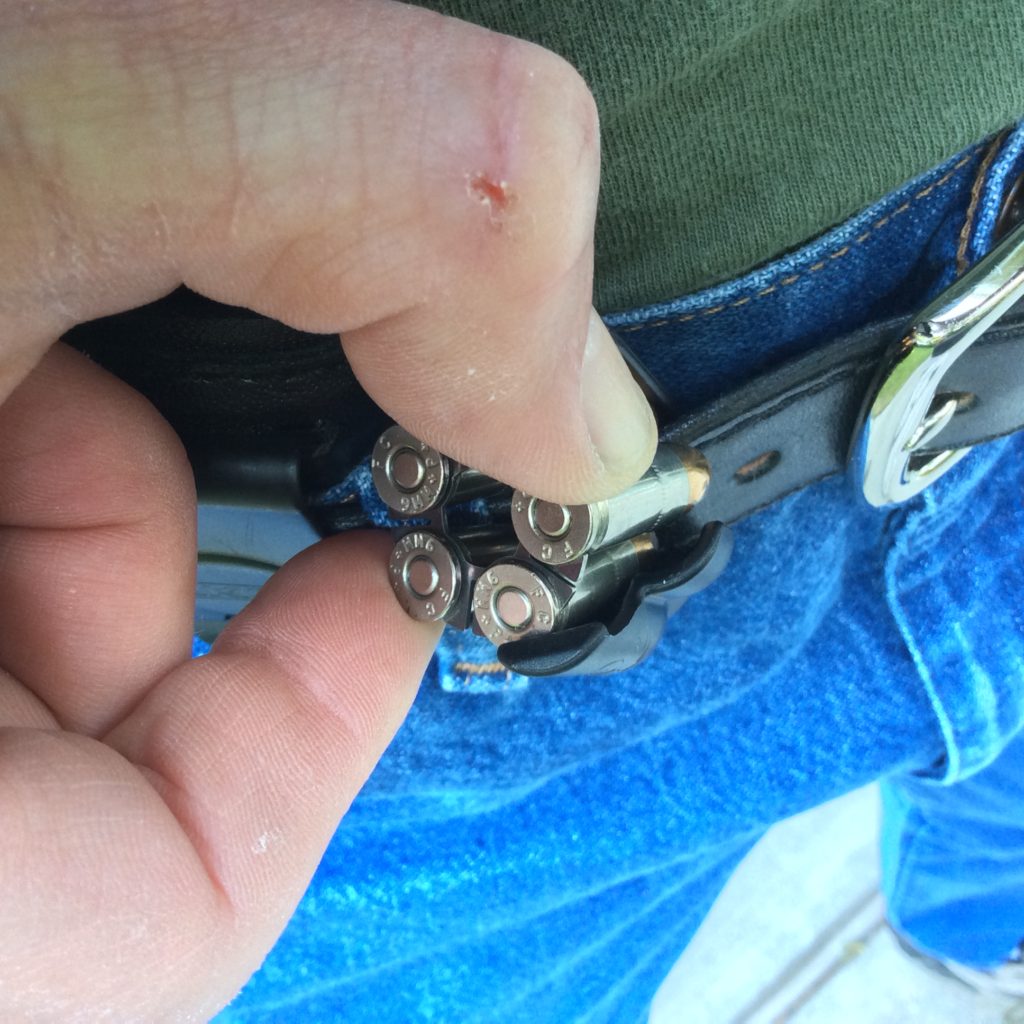
Of course, you could also use a strip-style loader or a pistol magazine to carry and load your spare ammo, but you’d have ejection problems later.
That’s a wrap
Justin was probably screaming at me to end this review about 2,000 words ago, so I’ll call it quits. The bottom line, if I haven’t made it clear, is that I’m VERY impressed with the metric LCR! There’s some quirks that go along with it being a clip-fed revolver that shoots autoloading cartridges, but if you can deal with those, you’ll be rewarded with an excellent little carry gun.
I’ll be working with the .38 Special version next, and will do a showdown between it and the 9mm LCR down the road, for those who might be interested in how they compare. Stay tuned to RevolverGuy for that and more, and be safe out there.
*****
Endnotes
(1.) The French eventually came to the same conclusion, themselves. The locally-produced Manhurin MR73 revolvers—which most police were equipped with, prior to the adoption of the PAMAS G1, then the Sig Sauer SP2022—could be fitted with 9mm cylinders, but seem to have been universally issued in .357 Magnum;
(2.) They did have some 9mm submachineguns which would remain in inventory, but there was no pressing need to ensure the handgun could chamber the same ammunition.
Liked it? Support RevolverGuy on Patreon!
Did you enjoy this article? Mike spent a month working on this 5,300-word review of the LCR. You aren’t going to find that just anywhere. Please let us know what you think it’s worth to get content like this. Without your support efforts like these are simply unsustainable. We appreciate it!


I greatly appreciate the depth of information you bring to these reviews, Mike. I am liking this gun in 9 now.
Perhaps Ruger is also thinking of the younger 9mm shooters who may want to try a first wheel gun? It would be an easier sell. For my own collection, I do not enjoy owning lots of different calibers, though I do reload.
Speaking of, I never understood why any reloaders would taper-crimp a revolver round. I bought a special die just for that final step. Never had bullet in three years creep, save in factory snakeshot rounds from CCI. Of course I was shooting a snake when that occurred…
Excellent article as usual. I have been fascinated by the 9mm snub since my friend picked up a 940 about a decade ago. Inexpensive practice ammo, wide availability of good SD rounds, and commonality of ammo with my soulless black plastic pistols – what’s not to like? As to moon clips, I have a 442 cut for them and have been looking for a good way to carry a reload. Previously bought a leather pouch but like Justin, I couldn’t get purchase of the reload – it was obviously a re-purposed speed loader pouch. Last week I found a company that makes a pouch similar to a second-six with a metal “post” that holds the moon clip.
http://jeffreycustomleather.com/MoonClip-MagazinePouchsAccessories.html
Ordered one. I’ll let you know how it goes once I receive it.
Excellent, please keep us posted!
Great article! To be honest for me the real draw of a 9mm revolver is as a backup gun (ankle or pocket) for an officer carrying a 9mm pistol. Unless you only had two pistols, this and a larger one, I don’t see any advantage picking this over a semiauto for AIWB.
Personally I think the negatives of the moon clips (hard to carry and the risk of bending them) and lack of extraction when loading loose rounds are big strikes against this compared to an equivalent.38 (which is lighter in weight). That is a shame as the 9mm probably is ballistically better suited to a snub nose than either a .38 or .357.
I look forward to the upcoming articles on the .38 LCR and the comparison between the two.
Jason, funny you mention that. I wrote an article for PoliceOne on that very topic. When it publishes, I’ll link to it here. I think this would be an excellent BUG for an officer whose primary is a 9mm.
Great review. At one time or another I’ve owned every caliber of LCR. I now only own the 38 Special and 22 LR. That just changed yesterday when I picked up a new LCR in 327 Federal. Much more pleasant to shoot (with 85 grain American Eagle) than the 38 ever was.
Regarding my experience wth the 9mm LCR, I was initially a big fan. I did experience crimp jump but I soon learned what brands to use. It was when i tried to pocket carry the LCR using first the bantam boot grips then the crimson trace grips that I discovered how unpleasant it was to shoot without the Hogue Tamers. As I was looking for a dedicated pocket carry revolver I ended up selling the 9mm. Someone with more recoil tolerance than me or willing to keep the Hogue Tamers should love this revolver.
My Bantam Boot grips are on the way. I look forward to experimenting with them and seeing if they’ll be good enough for the job. Will keep you posted.
That .327 Fed Mag is no joke. It’s a high energy round, with a good kick. It got marketed for a while as a good choice for the recoil sensitive—“all the power of the .357 with less kick”—but that was off the mark, in my experience. Great cartridge, but not a lightweight! I’ll be eager to hear more about your results with it!
I think the “all the power of the .357 with less kick” bit is marketing hype, but that 6th round is real. That 20% increase is the reason I got one in .327 Fed.
Indeed! I think it’s a really neat cartridge, and that 6th round does make a difference. It’s just not your daddy’s .32 H&R, or your granddaddy’s.32 S&W! I think it’s best thought of as a low-end .357 Mag, performance-wise. It’s not the gentle, low recoil choice that the marketing guys said it was.
Now, the fact that you can put those lesser cartridges in the same gun opens up a world of neat possibilities . . .
Another well thought out article. The ONLY revolvers chambered for auto pistol cartridges I’ve ever used that never gave me trouble were my 3″ and 4″ S&W 625 (Model of 1989) and my Ruger Blackhawk Convertible 357/9mm.
The recoil ‘shove’ of the .45 ACP round in the revolver platform never gave any problems with the thousands and thousands of reloads I put through it – and I also used a rather heavy taper crimp.
Also remember that factory ammunition has a sealant around both the primer AND the bullet, so there is a bit more to hold the bullet in place than a mere taper crimp.
The big PITA was loading and unloading the moon clips, particularly in .45 ACP. Eventually Brownells had tools to assist, but early on it wasn’t so fun. However, loading up for an IPSC or later IDPA match with boxes of pre-loaded moon clips was the lazy man’s dream version of speed loaders.
If you have the .38 Special (or .357 Magnum) version, and want a backup platform to practice to the n’th degree proficiency with a revolver, this is a good platform since ammunition can be had for around 14c per round on line. Unless you’ve got the time, and you’re reloading your own .38 Specials, you’ll hard pressed to keep up with the ammo cost.
Fortunately, the 9mm clips from Ruger are easy on the fingers. Each chamber has a split finger on either side of the case that provides the tension, and they’re forgiving. That’s probably why they failed so quickly too, though. These aren’t as rugged as the traditional GI 1917 half moons, and such.
I had bad luck with this gun (mine was actually the exposed hammer version, the LCRx 9mm). Not only does it not like reman/reloaded ammo, it doesn’t like cheap ammo period. I had major bullet jump issues with 115gr Federal aluminum and brass. One time, two of the five bullets in the clip jumped the crimp with the brass ammunition. I wonder if the SP101 in 9mm would fare better with its increased weight. Cost of ammo is a major concern for me as those Federal 200 round packs are the majority of my practice ammunition. I live in California and we have background checks going into effect for ammo purchases on July 1, less than two months from now, and buying online is a major hassle as store-to-home shipping is illegal and a lot of FFLs in my area don’t want to bother with receiving the shipments and waiting for me to come pick them up due to limited space.
It’s an interesting question. Perhaps the heavier SP101 would have less rearward thrust, resulting in less bullet pull. I’m not surprised you had issues with the aluminum cased ammo, or the inexpensive brass. Again, this gun requires you to test and evaluate your ammo choices carefully.
I have had my Ruger LCR357 for 5 years now. 2 years ago I got it cut to be able to shoot 9×19 plus the normal .38 and .357. I did it for more flexibility and have had been believer since Chuck Karwan wrote about them in 1980s. I agree with being carefull about bullet pull. I have not had issues with quality factory ammunition. I love the easy reload and the much increased efficiency of the 9mm ammunition. It gives great balance –with power and ease of recoil compared to other 2. I also have a 9mm SP101 and Blackhawk Convertible 45 recently picked up a
Taurus M380 .380acp ultralite revolver—now that is intersting
I would also agree with above comment on LCR .327 as that is a wonderfull gun with so much capability.
That’s a neat idea, Eugene. You’ve got a versatile combo there.
Mike,
Another very good review, thank you! I have the LCR in .357 and occasionally use the boot grip. It is a bit different than using the Tamer grip. With the boot grip, I cut a piece of bicycle inner tube, rinse it off, and slip it on which helps make it a little bit “grippier” but not overly so. Just enough to get a better purchase on the smaller grip.
Looking forward to the comparison of the 9mm to the .38.
Thanks again,
Another Mike (not Mike Wood)
Thanks Mike (not MW)! I did the innertube thing with my early Crimson Trace grips for the K-Frame, and it’s still working great, decades later. I look forward to getting my set of Bantam grips and will keep the trick in mind.
Mike,
Thank you for the outstanding review of the Ruger 9mm LCR. While I doubt I will ever start making reloads, the issues with the moon clips might make me reconsider the 9mm. Speed loaders and I are still getting to know each other better, and lots of practice needs to be done to get more efficient.
At this point sticking with my Ruger .357 LCR using the .38 Special +P for carry will have to be what I focus on. Oh, and my Ruger SP101, which I have not carried yet.
You tell Justin that your novelette reviews are just perfect.
WGJ
Thanks Judy! Since I’m bucking for Justin to give me a raise, your timing is perfect! Let’s see, 10% of zero is . . . hmm . . . I might need to rethink this.
I hope the speedloader training goes well. One thing I would suggest is to hold the loader body with your fingers, so that your fingertips go to/past the end of the bullets. Your fingertips will help guide the bullets into the chambers as you mate the loader to the cylinder. You can see an example in the lead picture of this article:
https://revolverguy.com/introduction-revolver-reloads/
You can also see one in the middle of this article (look for the image with the orange-tipped dummy rounds) and one at the end (look for the image of the loader full of red dummy rounds in my left hand):
https://revolverguy.com/rg101-stressfire-revolver-reload/
This method will help you mate the loader more positively and quickly than holding the loader by the knob, and trying to stab the cartridges into the chambers.
Depending on your loader, once you have it seated, just push the body (for Safariland or SL Variant loaders) or knob (for Jet, Dade, and SpeedBeez loaders) forward to release the cartridges, or twist the knob (for HKS, 5-Star, and Pachmayr-Lyman loaders) to release.
Let us know if you have any questions!
Mike,
You are AWESOME! I will be checking out those links. I am using the 5-Star speed loaders. I had one heck of a time finding speed loader “holders” that worked easily enough – major fail on 3 different ones. I purchased a pouch to use at the AG&AG National Conference which worked better (10 speed loaders so I wouldn’t hold up a class to reload speed loaders where the others were shooting autopistols).
I know all about that 10% of zero increase since I retired and am busier than ever….
WGJ
Personally, I’d love to see a LCR or J Frame in .45 ACP. I think .45 ACP is well-suited for revolvers, despite its rimless design, as it offers a nice alternative to .38 Special without needing to step up into Magnums. Yes, .44 Special technically does all those things too, but .45 ACP is cheaper and more widely available.
It would certainly be neat. The only issue, at least in the J-Frame, is I’m not sure five rounds of .45 would physically fit. Currently .38s/.357s are packed in there pretty tightly. I think the cylinder would have to be widened which would necessitate modifying the frame.
Great article, I’m glad I wandered over here from luckygunner.
I’ve tested quite a bit of ammo in mine as well and found crimp jump failures with cci blazee 115 fmj and s&b 115 fmj. I’m wondering if the heavier bullet contributed to you not having that problem or if it is a function of my shooting.
So far I’ve run 480 (moon clips make keeping brass a breeze) Remington green and white box 115’s at the range with zero malfunctions. Remington bulk 115 HP, sign v-crown 124, and HST 124+P also performed well.
One thing to note, the cylinder release grub screw worked itself loose on mine so it needed to be backed out (not removed) and loctited.
I’m very happy with this gun, the bantam boot grips are excellent in the pocket using a Blackhawk tecgrip pocket holster. On the waist in a galco combat master I at times forget I’m carrying it. Recoil with them is distinct and sharper than with the hogue tamer, but the boot style allows me to get a higher grip on the back strap. I’m interested to hear your thoughts.
Great feedback Brian, thanks. We’re glad you found us and hope you’ll stay a while. I look forward to getting my Bantams and giving them a try, and you’ll definitely see a follow up post on that when I get some experience with them.
I didn’t measure any of the factory 115 or 124 grain loads I shot for bullet pull, but I suspect there may be some minor changes to OAL on those too. I only measured the 147 grain, because it was most likely to be the worst case.
I carry 2 full moon clips in a plastic pill bottle, the smaller size pill bottle fit closely on the clips. I place it in my front pocket. Don’t use the child proof screw on cap. Use the lid that you can flick off with your thumb.
That’s a neat idea. Thanks, Daniel!
Mike, you guys are costing me money!
First the K6S… now the LCR…
35 mm film cannisters work real well for holding loaded moon clips, just put enough foam or bubble wrap in the bottom to fill the extra space.
First reply here, and I have been reading Revolverguy for a short while now……..hooked, and swallowed the hook all the way to the gills!
I have a LCR 357, and carry it OWB whenever I can, in a leather holster by Vi’s Leather (small custom maker) and I can honestly say carrying one of these is a breeze!
My biggest concern when I first aquired my LCR were the stocks as the factory rubber wasn’t cutting it. I tried the Pachmayr G10 stocks…..perfection (at least for me), and better recoil attenuation in my hands. Now, mind you I shoot 180gr WFN for most everything I need, and found my little LCR preferred these best also. The G10’s are a bit longer, but not sticking to every piece of clothing outweighs that small “extra” overwhelmingly. They are also a bit wider, but that also makes them fit better in my hands.
I will say there is a difference in shooting my LCR vs my Wiley Clapp GP100 357 with the Hogue hard plastic stocks, but the difference isn’t noticeable until you start getting up past that 50-60 round count at high speed.
Lance, we’re glad to have you aboard, and appreciate the great review of the Pachmayr G10 stocks. It sounds like they really do the job nicely!
Very nice review. Thanks!
If I didn’t have thoughts about a K6, I’d be tempted to look at the 9mm LCR.
And I’m glad you highlighted the problem of short-stroking the trigger with the LCR. This is an issue I’ve seen with my .357 LCR, more in dry-fire practice than at the range. I think this is more of a training issue, but it is definitely something I try to be conscious of.
The downside being that if you haven’t trained to avoid that issue, it could become a big problem in a real-world high-adrenaline situation.
There is much to appreciate about the LCR, but that trigger return issue is a worry.
I agree that it’s mostly a training issue, Nix. If you’re thinking about a K6s, you’ll enjoy the next RevolverGuy post at the tail end of this month, as well as our prior coverage in these pages. Thanks for reading and commenting!
I’m glad to see such a thorough review. Thank you. I get a bit weary of quick reviews that sound as though the reviewer already had his review written before he touched the gun.
I used to only shoot revolvers. About 15 years ago, I sold all but two wheelguns and started playing with autoloaders. After 15 years of shooting autoloaders, I kept remembering how much I liked revolvers. I nearly bought a little S&W J-frame because it is so classic in form and function. Besides, I have an original S&W 686-nothing. It has been one of my favorite guns since I laid down cash and walked out the door with it. But after pulling the trigger on gorgeous J-frame, then pulling the trigger on the LCRx, I suddenly found surprising beauty in the homely little Ruger.
That trigger is really the star of that design! Glad you liked the review, Richard. Pull up a seat and explore some more of our work—I think you’ll enjoy it.
A suggestion for how to carry the moon clips easily in a pocket w/ minimal chance of bending the clip is to use one of those orange foam earplugs that has a base at the end. Load up the 9mm’s into the moon clip, roll the ear plug between your finger and insert it through the rear of the clip into the middle opening between the rounds. This acts as a ‘6th round’ for cushioning inside the pocket and removal takes less than a second when pulled from the rear.
Thanks for the tip, Michael!
So one of the targets says the slide locks up differently on the first round? What slide?
Exactly! It’s a self-effacing joke, Dave. I was trying to “sell” the excuse that the flyer was because the first hand-cycled round printed differently (as many gun writers claim, when talking about autos), but “realized” the excuse wouldn’t work. I guess my attempt at humor didn’t work for you!